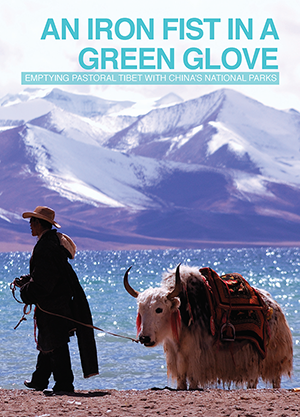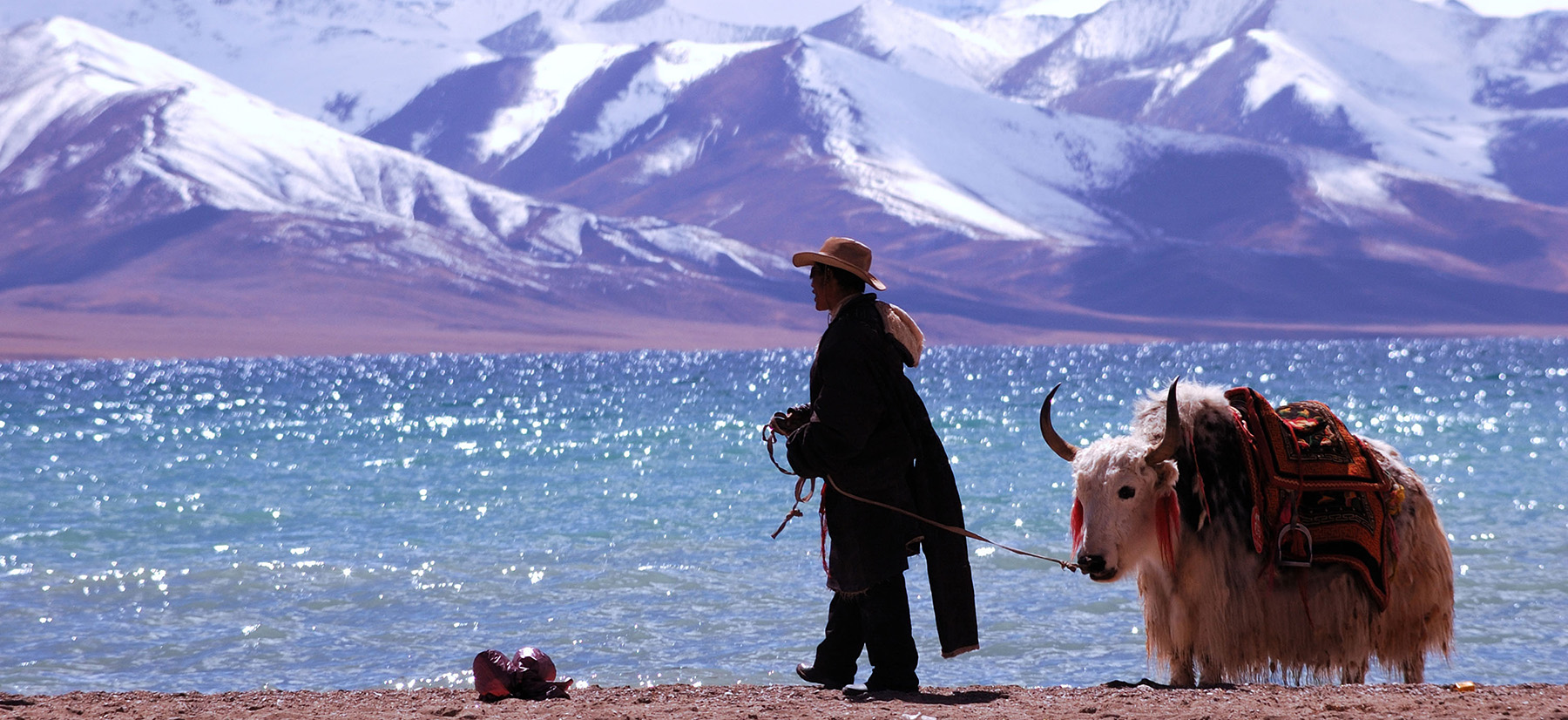
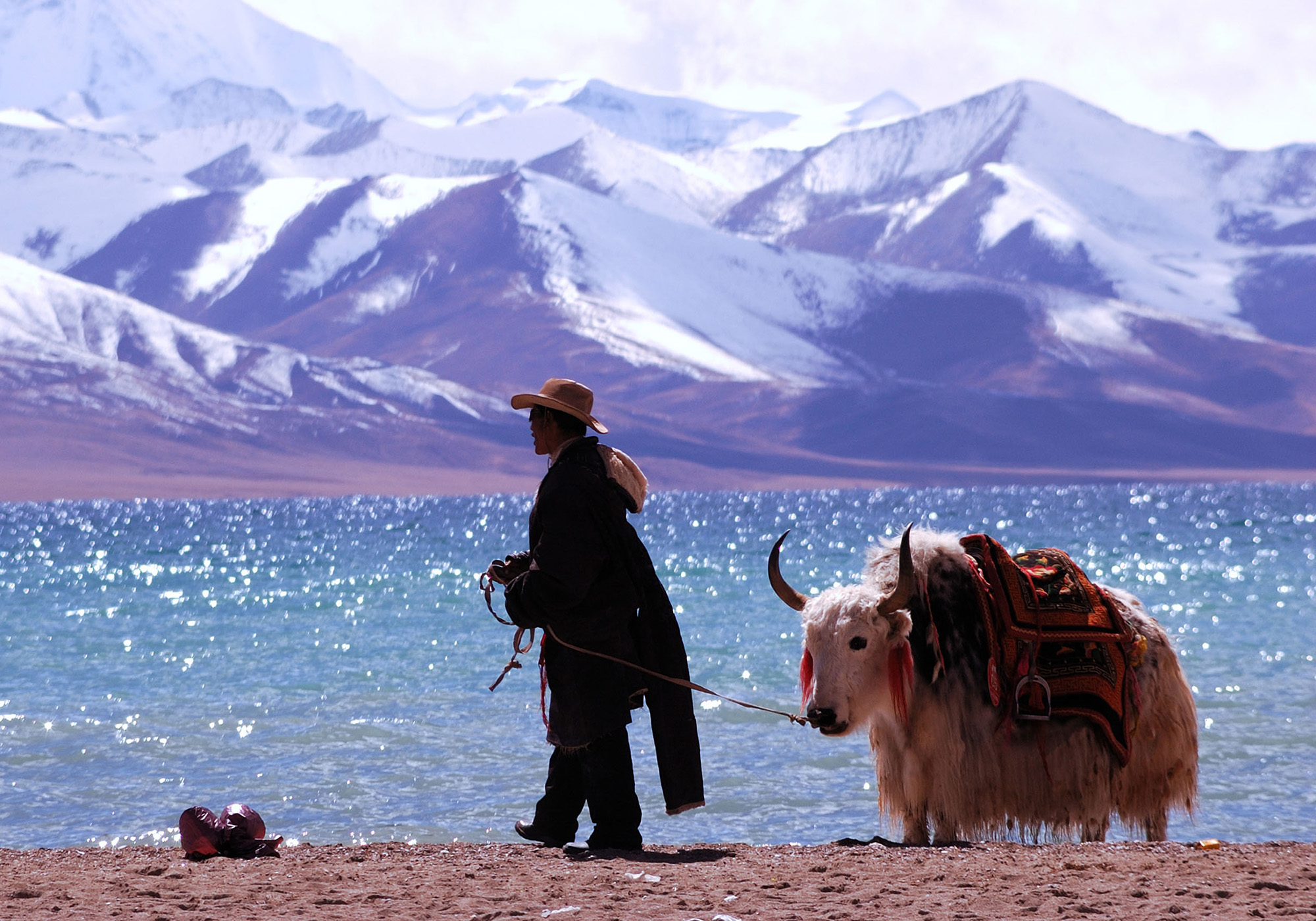
An Iron Fist in a Green Glove
Emptying pastoral Tibet with China’s national parks
The forced displacement of Tibetan nomads from their land is set to accelerate as China prepares to unveil a new system of national parks in Tibet next year.
Read our new report that challenges China’s argument that Tibetan nomads must leave their ancestral land in the name of development and environmental protection.
The report closely looks at how the Tibetan nomads have lived sustainably for centuries, the threat they are facing today, and why they must be understood as vital protectors of Tibet’s vast grasslands.
By Kyinzom Dhongdue, Gabriel Lafitte, Dr Simon Bradshaw
Full report below.
EXECUTIVE SUMMARY
Nomadic pastoralists have flourished sustainably on the Tibetan Plateau for hundreds of generations.
Glimpse into the world of Tibetan nomads, and we soon uncover a sophisticated way of life carefully tuned to the local environment, grounded in a deep connection to place, and guided by rich local knowledge and collective decision-making. Indeed, it is only the unique partnership between nomads and their animals that has made life on the cold, arid Roof of the World possible.
The nomads, like all those living close to the land, understand their lives depend on the health of their pastures, their water sources and the complex web of life that surrounds them, and so take no more than can be replenished to sustain them the next year. To the nomads, the landscape is sacred, inhabited by many spirits and deities, and fiercely protected. In this way, they ensure the Tibetan Plateau remains a healthy, biodiverse and productive ecosystem. And with the Tibetan Plateau the fountainhead of Asia’s great rivers, this is something upon which many millions of people beyond Tibet’s borders depend.
Today, as the world, including China, grapples with the intertwined challenges of climate damage, food and water security, inequality and biodiversity loss, the knowledge, wisdom and practices of Tibetan nomads are more applicable now than ever. However, this is not how China sees it.
For two decades, the Chinese government has been removing Tibetan nomads from their grasslands. This forced displacement is now set to accelerate under a new system of national parks, including four large parks stretching across the Tibetan Plateau.
While China seldom states this directly, a closer look at its elaborate plans for biodiversity protection, poverty alleviation, land restoration, securing water supply and climate change mitigation reveals that almost all involve the exclusion of Tibet’s nomads from their pastures. These plans, if left unchallenged, will mean the almost total demise of nomadic pastoralism in Tibet. An end to a way of life that had enabled Tibetans to live successfully and sustainably for millennia.
Years of testimony from displaced nomads coupled with a growing body of scientific research shows that these policies can be devastating for communities, harmful to the environment and counterproductive to all of China’s stated aims. Further, that Tibetans themselves can offer vital solutions to the challenges that China is purporting to solve.
Traditional nomadic grazing can play an essential role in reversing grassland degradation, which has been brought about by decades of policy mistakes under China, including constraining the mobility that has been crucial to sustainable pasture management in Tibet.
With downstream water security – China’s number one priority – dependent on healthy upper catchments, Tibetans, who have been determined through the ages to protect these sacred water sources, must again be seen as part of the solution, not a problem.
When it comes to efforts to sequester more carbon in the Tibetan landscape to offset China’s burgeoning greenhouse emissions, China will likely gain nothing by removing nomads and their herds from the grasslands. On the contrary, maintaining soil carbon long-term depends on careful management and is aided by the presence, not absence, of the traditional custodians.
Similarly, ungrazed and depopulated grassland in Tibet loses biodiversity as longer grasses and the hardier species begin to dominate. Also, when it comes to iconic wildlife such as snow leopards and wild antelope, Tibetan patrols were, until recently, the only safeguard against poachers.
Lastly, the experiences of displaced nomadic communities make a mockery of China’s claim that forced resettlement is necessary to alleviate poverty. In their own words, Tibetan nomads, when out on the range, consider themselves wealthy. It is only when stripped of their traditional livelihoods and forced to the urban fringe and left to survive on handouts; they become impoverished.
A better way forward is possible: A path of cooperative, inclusive solutions that protect biodiversity, ensure secure land tenure, promote food and water security for all, and uphold Tibetans’ right to choose their future. Many joint initiatives of Tibetan, Chinese and international NGOs in recent decades have demonstrated what is possible – how it is not a matter of choosing between environmental protection and human livelihoods, but how both can, and indeed must go together.
While on the surface, the announcement of new national parks spanning Tibet may seem like welcome news, Australia Tibet Council strongly encourages all interested parties including environmental NGOs, development agencies, government and parliamentarians to consider the consequences of China’s current plans for Tibetans. The international community should not welcome these national parks until China genuinely embraces collaborative management approaches that value the role of Tibet’s traditional custodians and uphold their rights, thereby promising a secure and dignified future for Tibetans while protecting the Tibetan Plateau for all humanity.
With the fate of Tibet’s remaining nomads now hanging in the balance, the task ahead is clear. It is vital that Tibetan voices are heard. Also, the global community of conservationists, development practitioners, and human rights defenders works collectively to challenge China’s policies towards Tibetan nomads while advocating strongly for a cooperative and inclusive path forward.
INTRODUCTION
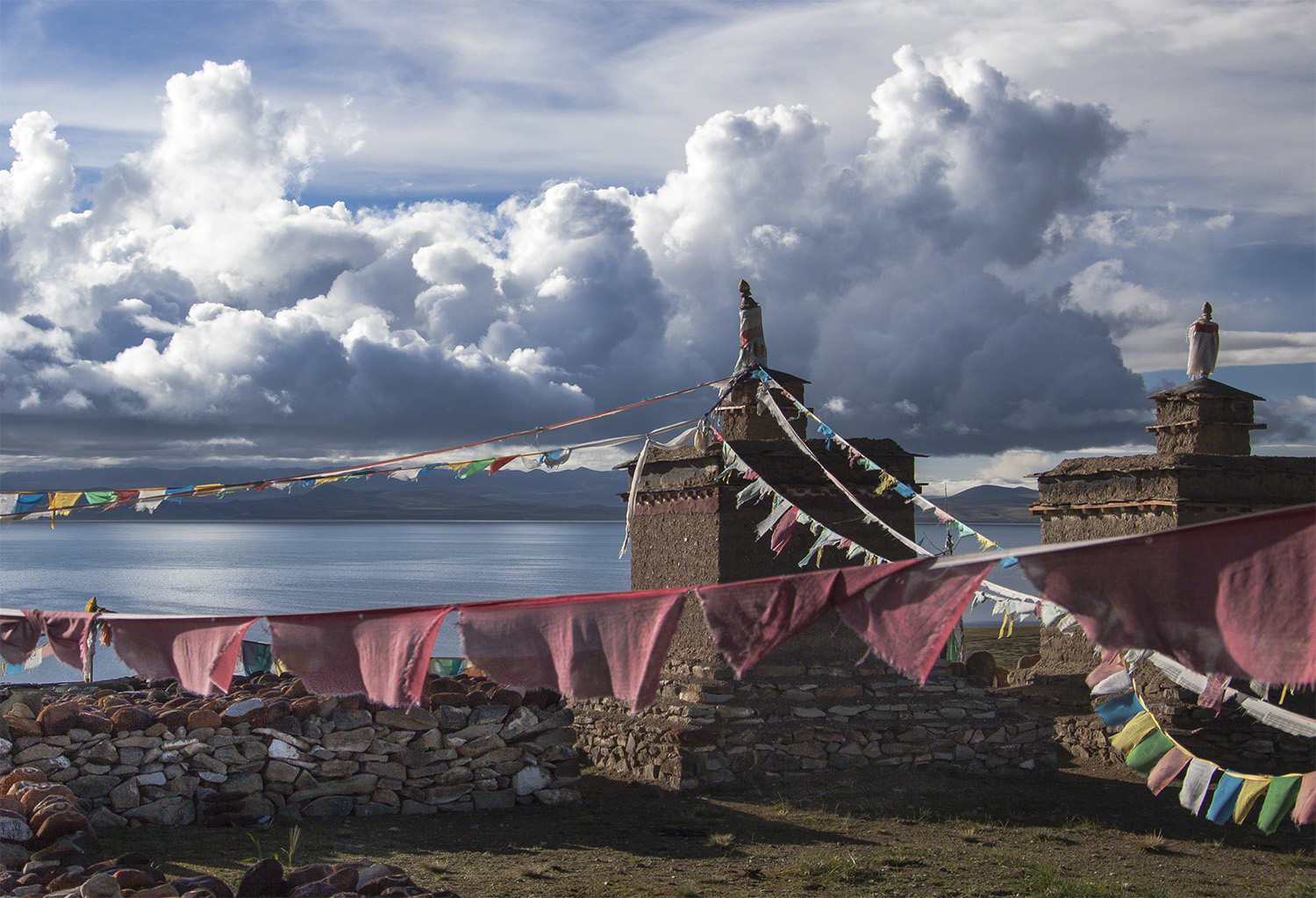
© John Birchak
The news out of Tibet is all good, at least on the surface. New national parks will open in 2020, guaranteeing the Chinese government will protect threatened wildlife, including Tibet’s iconic species such as snow leopards, wild yaks and Tibetan antelope, and also rare medicinal plants.
After decades of exploitation and intensive mineral extraction, big new national parks stretching across the Tibetan Plateau sound like a good move. So why are the Tibetans not rejoicing, after decades of Chinese control over Tibet causing pollution and destruction of their environment? Surely a shift, from plunder to protection is just what the Tibetans, a predominantly Buddhist population with a long tradition of respecting nature, would want?
It is not as simple as the story China, an authoritarian regime, tells the world about its new enthusiasm for wildlife and empty, pristine wilderness landscapes populated only by wild animals.
China’s national parks plan requires depopulating Tibet. Nearly all human presence, from miners to pastoralists, is declared a threat and has to be removed. Only scientists and park staffers will remain.
This report challenges China’s unacknowledged assumption that nearly all nomads (known in Tibetan as drogpa) must leave. China seldom says this directly. Instead, China makes elaborate plans for biodiversity conservation that happen to exclude almost all human presence from defined core and buffer zones. China announces poverty alleviation as a top priority, and only in the fine print that in many areas, especially in officially labelled “contiguous destitute areas” of Tibet, the solution to poverty is to remove the people to towns and cities. Similarly, China’s policies on land degradation, water supply and climate change adaptation all happen, in the fine print, to exclude nomads from their pastures.
This report plunges into that fine print, into the menu of policies China has announced, which leaves nowhere for nomads to maintain their traditional, skilful, sustainable stewardship of a land so vast it is one-quarter of modern-day China.
Having assessed China’s policies and their devastating consequences for sustainable Tibetan landscape and biodiversity stewardship, this report then suggests constructive alternatives. In the past, Tibetan domestic and wild herds mingled, sacred areas were respected. What worked before China asserted mastery over the unfamiliar rangelands of Tibet can work in the future. This report itemises the many joint initiatives of Tibetan, Chinese and international NGOs in recent decades to protect biodiversity and human livelihoods together, and proposes cooperative, inclusive solutions.
For these reasons, we ask conservationists and development agencies worldwide to pause before congratulating China on what may seem to be all good: new national parks. We ask them to hear Tibetan voices, evaluate the negative impacts independently and encourage China to recognise Tibetan nomads as part of the solution, especially in degraded areas needing labour-intensive rehabilitation.
Nationalising vast Tibetan landscapes and repurposing them as mass domestic tourism destinations will cause many consequences. The new national parks mean the end of the traditional Tibetan mode of production, an end to Tibetan land tenure security and collective food security; replacing productive and sustainable landscape management with idle lives on urban fringes dependent on rations handed out by the state, which expects gratitude in return.
Sadly, the story will be all too familiar to indigenous and local communities in many parts of the world. From Indian tribes illegally evicted from the forest to make way for tiger reserves, to Indigenous Australians who have survived over two centuries of colonisation. Only belatedly are governments coming to recognise that the best way to protect forests, grasslands and other ecosystems is to uphold people’s right to remain on their ancestral homelands and to support traditional land management practices.
At the heart of this Tibetan story are two universal themes – the right of all peoples to determine their future and the value of traditional knowledge and practices when confronting the significant challenges of today.
This is not a romantic, outsider’s view of traditional Tibetan life, nor does it deny Tibetans’ right to development and modernity. We aim to propose an inclusive solution. A solution based on a new respect for the experience and wisdom of Tibet’s nomads, and their freedom to maintain and enhance their traditional livelihoods, an essential part of a sustainable future for Tibet, China and the wider region.
It is, therefore, a story of hope and solutions. However, also one of great urgency.
PART 1: BACKGROUND
Nomads, their grasslands and sacred spaces
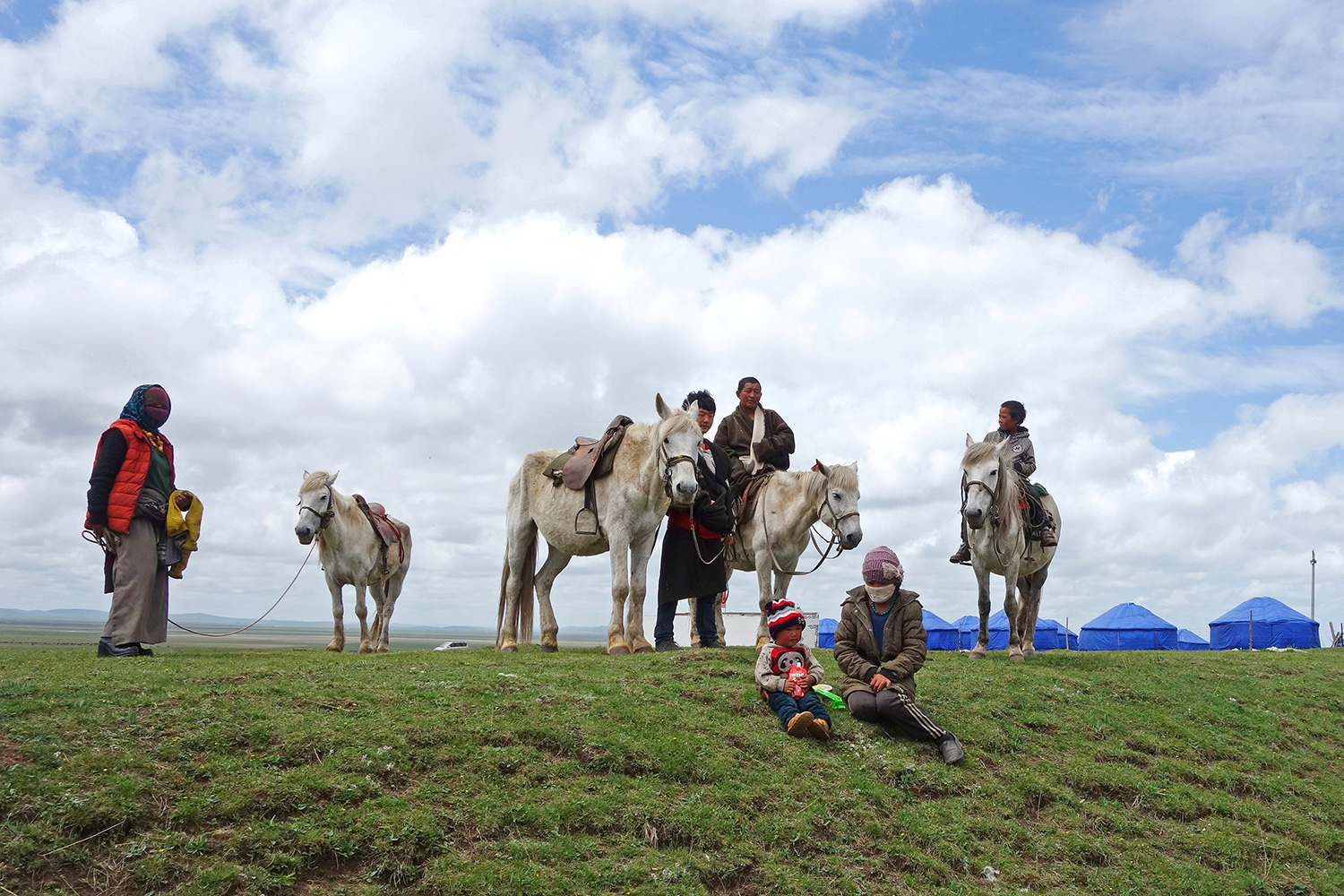
The Tibetan Plateau is unique, a vast island in the sky, so frigid it takes special people, and a unique partnership with animals, to make it habitable. Nomadic pastoralism – the herding of livestock from one pasture to another – is what has made human life on the cold, arid Tibetan Plateau possible, productive and sustainable.
Nomads move their herd on before the land becomes overgrazed or when the seasons dictate it is time to move, allowing the grass to regrow. Some nomads move cyclically between fixed summer (highland) and winter (lowland) pastures.
Tibetan pastoralists usually know each animal in the herd. When herds are mingled to graze and then again separated, the animals know the unique call of each pastoral family. Tibetans consider themselves wealthy if they have a herd on the hoof, and are reluctant to sell for slaughter, as herd size is collateral, insurance, dowry, working capital and the best strategy for recovery if disaster such as blizzards and gales hit unpredictably.
Over centuries, herders developed sophisticated practices carefully adapted to local conditions: determining the best migration times and routes and the optimal size and mix of animals (yaks, goats and sheep). Decisions on when and where to move are made collectively by groups of families.
Traditionally, nomads’ herds provided for almost all their needs: the yak’s coarse wool was used to make tents and ropes, its bones to make tools, its milk drunk or preserved as butter and yoghurt, its dung used as fuel for cooking and its meat their primary source of protein. Sheepskins kept people warm. It was a life of few needs, with plenty of leisure for family life and daily spiritual practices honouring the local gods of the waters, trees, lakes and mountains.
In turn, the animals ensured the grasslands remained a productive, biodiverse and healthy ecosystem – fertilising it with their dung and eating or trampling away weeds. The nomads and their herds co-existed and shared the pasture with wild animals, including migratory herds of Tibetan antelope, gazelle and wild yaks. Their mobility, preparedness, the collaboration between families and rich local knowledge enabled nomads to be resilient in the unpredictable and capricious nature of their environment.
Until relatively recently, the story of life on the Roof of the World was of symbiosis between Tibetans and their herds. This is what scientists today term a coupled human and natural system.
China’s solutions to the problems China created

When China took command of the Tibetan pastoral landscapes in the late 1950s, intensified production was the goal, collectivisation of herds and herders the method to achieve it. On the communes, the former traditional pasture owners had to meet production targets set by communist cadres with the power to withhold survival rations if people did not meet their quota. The emphasis was on building herd size as quickly as possible, and on accelerating slaughter rates.
The nomads worried that forcing nature to submit to human will offend the water spirits and local gods, resulting in disaster, but were powerless. The great famine of 1960 through 1962 then took place. The communes failed but did not collapse until the late 1970s, two decades in which sedentarised nomads had to build fences to pen animals, without wire or posts, by digging the living turf and piling sod on sod high enough to deter animals from seeking pasture.
Starting in the 1980s, China went from the extreme of communisation to that of making each family separately responsible for a specified allocation of land, usually suitable only as winter pasture, which had to be fenced with wire and posts, financed by mandatory bank loans which put nomadic families in debt.
The outcome of this “household responsibility system” was loss of mobility, the flexibility to move with the herd according to grass growth and seasonal change in a highly uncertain climate. Fencing led to disputes between neighbours and between clans, where before there had been ambiguity as to where one pasture ended and another began.
In the words of a senior nomad, Puntar:
“At that time, the livestock had to graze in a small area, following the same grazing orbit every day. As a result, the vegetation was consumed more quickly, resulting in inadequate forage. Plus, we could not move to the winter pasture as it did not belong to us. We had to stay at the settlement for three seasons (winter, spring and summer). The livestock was getting weaker and weaker, and there was little fat on meat…. We lost many livestock.”
As we explore in the next section, this now well-established pattern of top-down, coercively applied ‘solutions’ to problems of China’s own making continues apace.
PART 2: DISMANTLING CHINA’S JUSTIFICATIONS FOR DISPLACING NOMADS
Land degradation: Causes and cures
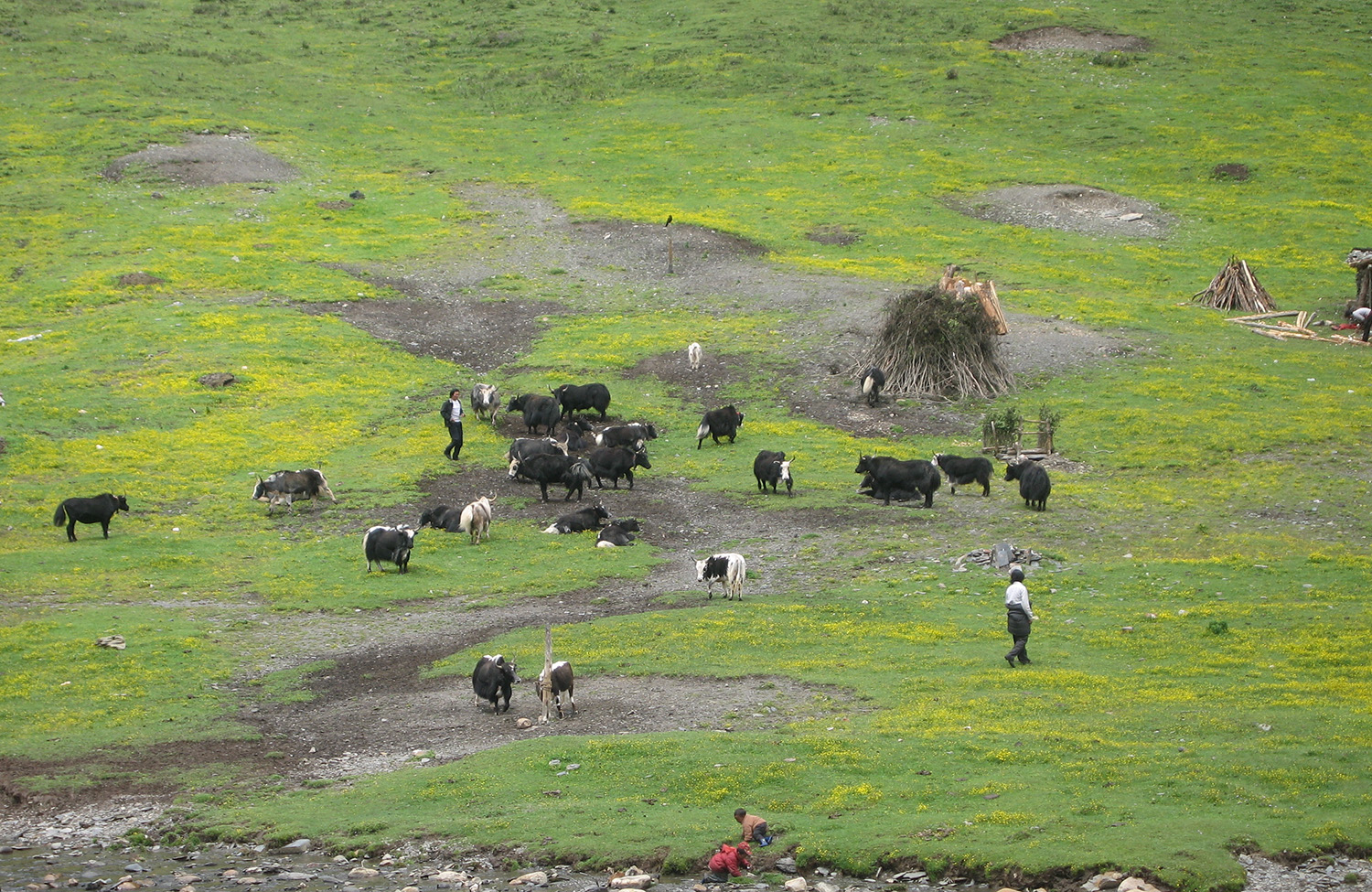
© Lobsang Khokze
Covering more than half of the colossal Tibetan Plateau, Tibet’s grasslands are one of the world’s most important grassland ecosystems.
The compulsory fenced enclosure of animals had inevitable results. Overgrazing by demobilised herds killed the hardy grasses accustomed to both winter cold and moderate grazing. They keep most of their biomass below the surface, well protected from ungulate teeth and gales. Bare earth erodes. Chinese scientists attributed this to ignorance and carelessness of the nomads, following the capitalist assumption that common pool resources will always be overexploited, since nobody owns them. China’s solution to this “tragedy of the commons”, a thoroughly discredited American 1950s concept, was individual ownership as the only incentive to herders to keep their exclusive land tenure rights viable.
It did not work out like that. Tibetan pastoralists, accustomed to living off uncertainty, know how many animals on the hoof they need, not only for subsistence but as their only insurance against sudden hail and snow storms. They cooperate, reach consensus and seasonally pool their herds.
Chinese researchers rarely spoke with herders or understood the dynamics of mobile pastoralism, relying instead on their remote calculations of generalised carrying capacity and stocking rates, concepts that poorly fit pasture lands of a unique high altitude plateau the size of Western Europe. China never looked into how nomads communicate and reach consensus on caring for their animals and their land. It was only in 2018 that a scientific analysis of nomad communications strategies was published.
These Chinese policy failures are the unacknowledged causes of land degradation. To this day, they cannot be spoken of, because the ruling Chinese Communist Party insists it has always been right and any suggestion of past policy failure is considered “historical nihilism”, a severe offence.
Further policy mistakes occurred. Nomads were instructed to erect fences, plough seed, weed and harvest plots for fodder crops to help animals penned over winter not to lose weight. The intention was good, but most of the labour had to be done in the short growing season when nomads are at their busiest and most mobile. New fencing and farming equipment had to be financed by further loans and further debt, even though the public rhetoric was about poverty alleviation. At the same time, local schools were closed, replaced by centralised boarding schools, requiring nomads to send children away, making them unable to assist in the peak production season.
Another policy mistake was the compulsory mass poisoning of a keystone species of grassland rodents – the pika – in the mistaken scientific belief that they were responsible for grasslands degradation. Tibetan nomads found these policies distressing but had to comply. The actual work of poisoning was done almost entirely by Tibetans, financed by development assistance from the German government.
Decades of a top-down misunderstanding of the dynamics of the rangelands resulted in widespread degradation, with the nomads blamed. Top-down command and control by cadres implementing policies made far away replaced local knowledge for too long.
Then there was the implementation of individualising property, which not only resulted in land degradation; but also a weakening of social bonds in nomadic communities: “The disruption of social networks by the imposition of property lines between individual households acted to limit cultural transmission and collective benefits, such as the sharing of labour, pasture and food. Moreover, the Individual Private Property system seemed to lack the necessary resilience that is required to support the communities and their livestock.”
Degradation is always local, requiring local solutions. Rehabilitating degraded pastures is labour-intensive, requiring stabilisation of slopes and the replanting of native species suited to the climate, followed by seasonal protection of young plants from the extreme weather events that in Tibet, as elsewhere, are becoming more common due to climate change.
It is not traditional grazing but rather a combination of relatively recent land use changes, brought about by the Chinese government, coupled with the impacts of climate change, that is key to explaining the alarming levels of grassland desertification and degradation that we see today.
However, ignoring a mountain of scientific evidence to the contrary, the Chinese government has held to a simplistic and all too convenient explanation: overgrazing by Tibetan herders, whom it regards as backward, primitive and ignorant. This is a striking example of modern-day colonialism and racism. It overlooks the fact that Tibetan nomads flourished sustainably on the Roof of the World for a very long period before Chinese colonisation, their practices mostly unchanged for centuries. The damages we see today coincided with the decades of rapid change under China’s rule.
One analysis of a wide range of hypotheses for grassland degradation concludes: “The mere fact that most rangelands of concern are considered to have been in much better condition only a few decades ago is sufficient to conclude that traditional pastoral systems can be consistent with long-term sustainability, and thus cannot, of themselves, be identified as a cause of degradation.”
Traditional herding is not the cause of today’s problems. In fact, it can be an important part of the solution to the current challenges. Well-managed grazing, built on traditional practices, can be crucial to grassland restoration. It includes building back healthy soils that store increasing quantities of carbon, supporting a healthy, diverse and productive ecosystem while playing a part in limiting atmospheric carbon pollution and climate damage. Indeed, the opposite, the exclusion of all grazing and the removal of nomads from the grasslands, has been shown by some studies to lead to a reduction in soil carbon. While others have shown that grazing bans are at best no better for rehabilitating grasslands than grazing at sustainable levels.
Restoration of grassland health is labour-intensive and requires the presence, not absence, of the traditional custodians.
China’s number one priority: Acute water shortage downriver
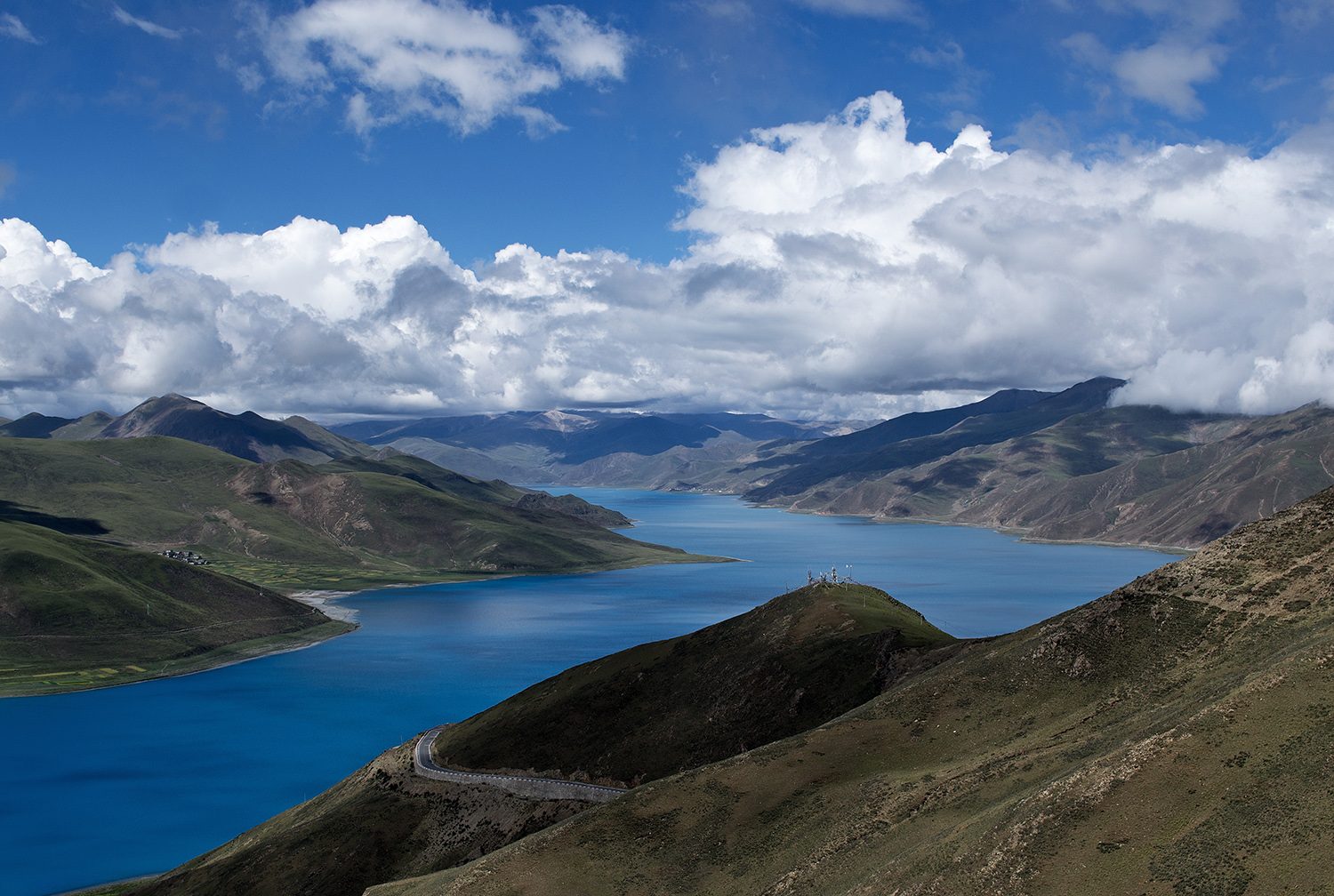
Tibet’s grasslands also lie at the source of many of the great rivers of Asia. Rivers upon which 1.7 billion people in the south, east, and southeast Asia depend.
Healthy grasslands act like a sponge. When the snow melts from the mountains, the water soaks into the soils before it is then slowly released downstream or seeps further underground to replenish groundwater reserves. This means there is a relatively steady flow of water into the rivers. Without the grasses and soils to regulate the flow, the water runs off all at once. Put simply, losing the grasslands has grave implications for water security in China and beyond.
China’s policy towards Tibet now prioritises water provisioning above all else. Anything that gets in the way of water provision from the upper catchment in Tibet is dispensable. The best pasture land in Tibet is between the pristine (but melting) glaciers in the highest mountains, from where the rivers originate, and the lowlands where water is needed. Both the Yellow and Yangtze traverse the pastures of the high plateau. If the many Tibetan tributaries of the Yangtze are included, these rivers flow for thousands of kilometres in Tibet.
Rather than honouring the Tibetan nomads as river keepers and stewards of water purity, or rewarding them with payments from lowland users for upriver guardianship, China sees nomads and their herds as problematic.
China has decided that water is the most important commodity it can obtain from Tibet, including the hydroelectricity extractable from Tibetan rivers. Water is more valuable to China than pastoral production, even though China today eats far more meat, now produced mostly in factory farms. China imports raw materials for its factories from all over the world. But cannot import water both because it is too heavy to ship and the quantities required are so vast. The solution is upriver Tibet, “China’s Number One Water Tower”, a popular official slogan, and the three major rivers – the Yangtze, Yellow and Mekong.
Does delivery of water from Tibet to lowland China necessitate the removal of pastoral nomads, who believe that the rivers, wetlands and lakes of Tibet abound in lu, water spirits that must be respected, not offended? That means not polluting water, greedily extracting too much, not draining wetlands or damming rivers. The widespread belief among Tibetans is that lu are particularly sensitive to pollution and developments through which man violates the environment. The lu are reputed to seek vengeance when they are disturbed, notably by giving the guilty parties illnesses or by altering the balance of the local water table, which results in rivers drying up or abnormally heavy rain. These are powerful and effective constraints on bad behaviour.
In northern China, the shortage of water for industrial, agricultural and urban use is so acute that Tibet seems the only solution. China’s rigid zoning system classifies all land as either economic or ecological, and the rivers, once they leave the high plateau are classified as economic, even when they flow through UNESCO World Heritage protected areas, thus making them available for hydro damming. Further upriver, where the Yangtze, Yellow and Mekong water a vast pasture land, they are classified as solely ecological, which means that all human use, including traditional livestock herding, is defined as a threat, usually requiring exclusion.
In contemporary environmental governance, provision of water for the use of distant downstream users is recognised as an important environmental service. Downstream consumers may pay the upstream conservers (through schemes known as payment for ecosystem services – PES) to compensate the upper riparian communities for incurring the opportunity cost of not developing.
Do China’s lowland factories and cities compensate Tibetans for foregoing development? The only payments by the state are conditional on vacating the land and living in high-density concrete settlements on urban fringes, thus qualifying for transfer payments, usually in kind rather than cash, in bags of rice and flour, vulnerable to corrupt skimming as they pass through many hands before reaching formerly self-sufficient nomads now reduced to dependence.
Anthropologist Xenia de Heering retells a conversation with Drolma Tso, a nomad woman:
“Of course locals are afraid to dig near a spring, they are afraid because according to the Tibetan perspective, there are, like, water deities there. If we dig around there, maybe it will bring disasters, like illness, and even kill people. So I hired some Chinese people to dig near the spring. But it rained a lot, and then local people started to say, It rained a lot because we dug there!… I’ve always believed there are water deities… So I asked all the monks to go near the spring and chant prayers.”
Downstream China wants its water from Tibet, not in the summer monsoon season when the problem is too much rain and the danger of flooding. The water is wanted in the other seasons, a primary argument used by the dam and power grid construction corporations for building more dams across Tibetan rivers.
However, the best seasonal regulator of year-round water availability is intact glaciers at the river sources and intact forest cover on the steep slopes above the rivers as they start to plunge from the high plateau.
Climate change has accelerated glacier melt, providing downriver China with a dividend of increased runoff that may persist, on current trends, until the glaciers have melted by the middle of this century. The Tibetan forests and wetlands that soak up the heavy summer rains were intensively logged and drained by China, over several decades, from the 1960s to the end of the 20th century, and little has been done to restore them.
Chinese scientists in Tibet say: “Forested vegetation types were best able to regulate surface runoff. Land use changes have dramatically affected water conservation in the study area in the past several decades; if forested land cover existed at the levels present in 1986 or 1974, the ability of the watershed to intercept surface runoff would increase by about seven percent and three percent, respectively, over its capacity in 2000.” It is surface runoff that causes erosion, degradation and floods.
As discussed in the previous section, the degradation of the grasslands – and consequent implications for water security – are best explained by a series of policy mistakes by the Chinese government. In particular forcing nomads to fence their herds, constraining the mobility that had enabled animals to tread only lightly across a vast range, and instead concentrating their grazing in smaller areas, which then gradually degraded. The mandatory enclosure of each family’s herd drastically reduced the mobility, which has always been the secret of sustainable pasture management.
Climate change: Does it makes nomads redundant?
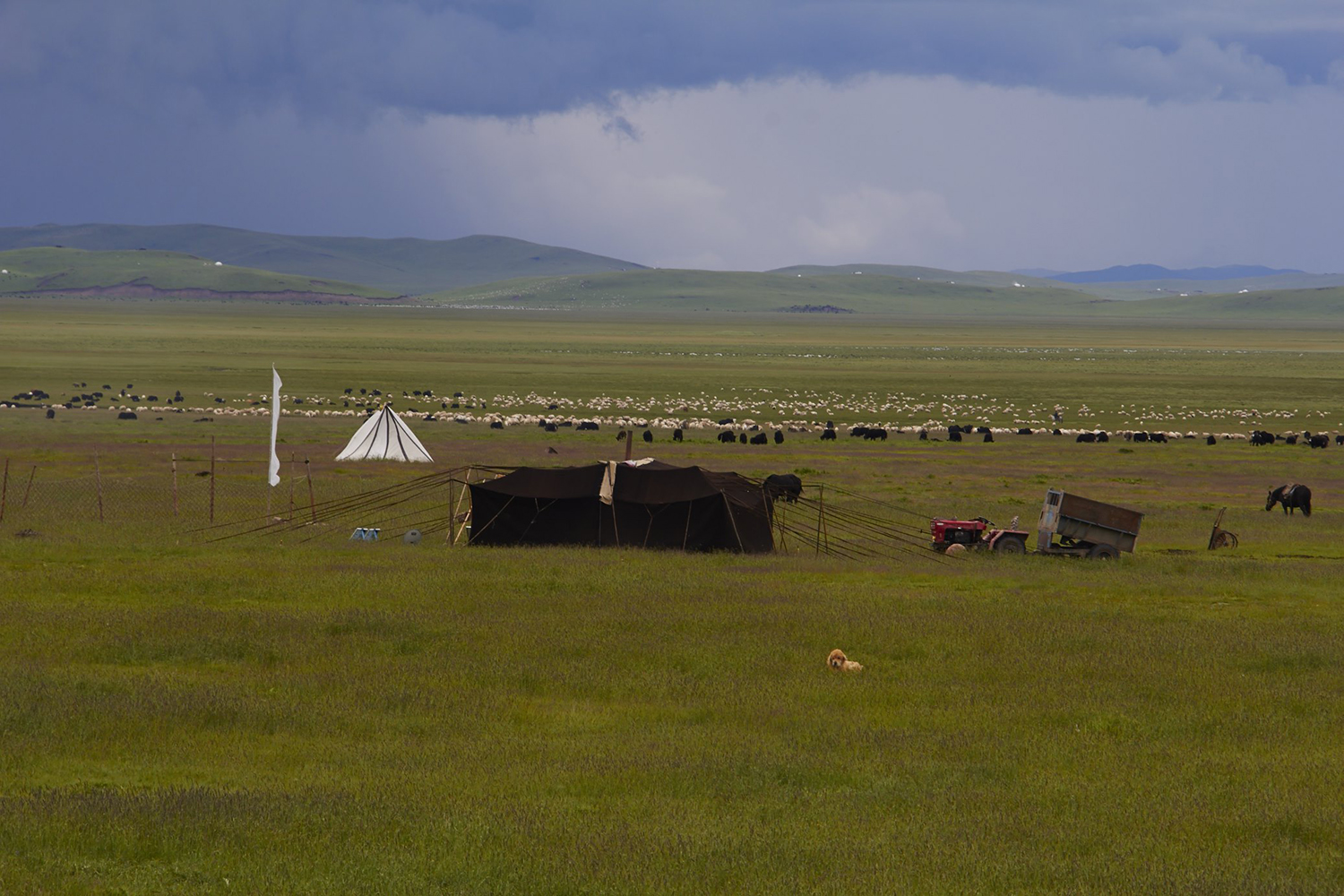
© Kunchok Gyaltsen
While the biggest of the world’s emitters of greenhouse gases argue endlessly over who has greater responsibility, many other peoples are caught in the crossfire. It is the great misfortune of the Tibetans to have been incorporated into the biggest emitter of all, which, on historical grounds, argues against accepting equal responsibility to reduce emissions. China has given only an unquantified pledge to reduce emissions, starting in 2030. China’s Nationally Determined Contribution (NDC) to the 2015 Paris Agreement, if followed by other countries, is a promise to lift climate warming by century’s end by a disastrous 5.1°C.
Under pressure to lift its game, China turns to Tibet to improve its credentials for the capture of carbon, offsetting ongoing emissions. The new national parks, covering nearly 30 percent of the entire Tibetan Plateau (see table and map in the Biodiversity section), are designated protected areas whose exclusive functions are to protect China’s water supply, grow more grass, and conserve biodiversity. These worthy goals need not exclude ongoing herd grazing under the skillful stewardship of the traditional land managers, the nomads of Tibet; yet China has designed the parks to largely exclude the nomads from their lands.
Like forests and mangroves, grasslands store vast quantities of carbon in their soils. When they are degraded or die, this carbon is released into the atmosphere, adding to the carbon pollution from the burning of fossil fuels and pushing the world further towards climate catastrophe. In a vicious cycle, more warming means more degradation of grasslands and other ecosystems, which leads to more soil carbon being released, which in turn fuels more warming.
A key question for all who seek to avoid a future of far greater climate disruption is whether the clearance of traditional owners from their pastures across Tibet is necessary, or indeed counterproductive. Does the implementation of China’s official slogan “Close pastures to grow more grass” sequester a significant amount of carbon from the atmosphere into the soil? If the nomads of Tibet surrender their land tenure security, becoming “ecological migrants”, does their sacrifice, whether voluntary or not, make a real difference to global atmospheric carbon levels? Is Tibet a net emitter or storer of carbon, with or without the nomads’ herds of yak, sheep and goats?
These are not just questions for China since it has put its redline maps of national parks in Tibet into the global debate on who is doing what, as part of the global carbon market. After grazing bans are enforced, grass does indeed grow to greater biomass. There is abundant scientific measurement of that. For a few years, at most, biomass increases in the absence of ungulate teeth. Then what?
Under the official policy of tuimu huancao (Close pastures to grow more grass), in effect since 2003, there is now scientific evidence of the longer term consequences of reducing the best pasture lands to a single metric biomass. Unlike a forest, there is a limit to how much carbon grasses can sequester, and for how long.
Ungrazed depopulated grassland in Tibet loses biodiversity, as longer grasses outcompete the low herbs required for traditional Tibetan human and veterinary medicines. Loss of biodiversity leaves hardy grasses and sedges dominant, often succeeded by shrubs, but not trees. Grassland fire risk grows. If carbon sequestration is to be meaningful, captured carbon must stay reliably in the soil for decades, and carbon offset contracts specify this.
The reality on the ground in Tibet is more complicated. Not only is the climate more extreme, across a vast island far up into the troposphere, it is also highly variable. While China calls Tibet its’ ‘number one water tower’, the reality is that the Tibetan Plateau is arid compared to the lowlands, its glaciers are rapidly losing mass, and seasonal permafrost now melts earlier and faster, releasing methane into the atmosphere. Depth of permafrost has decreased by 6.5 cms each decade, and permafrost melt each year now happens between 3.2 and 7.6 days earlier. The resulting methane emissions are disastrous, not only for Tibet but for the planet.
China’s dividend of increased river flows due to glacier melt will turn to deficit when the glaciers are gone. That will take most of this century far away enough for little immediate concern; and perhaps compensated for by increasing precipitation. For thousands of years, lake levels across Tibet have been slowly falling, as monsoon rains reaching into Tibet from the Bay of Bengal through the Himalayas lost some intensity. That has now reversed especially in the land of lakes of northern Tibet. The summer of 2018 was one of the wettest known in Tibet, and Chinese scientists now worry about lakes breaking their banks and flooding far below.
On paper, the removal of livestock should remove methane emissions, even if the populations of wild Tibetan gazelles and antelopes surge, as planned. However, emissions from animals on pasture are much less than China’s intensification of meat production in factory farm feedlots reliant on importing tens of millions of tons of soybeans across the Pacific from growers in the Americas. Growing rice in flooded paddy fields generates at least 15 percent of global methane emissions, but no one suggests that southern China stop growing rice.
As yet, there is no clear evidence as to whether the Tibetan Plateau – close to two percent of the planetary land surface – is a net emitter or capturer of carbon, or whether the clearance of herds and herders from 660,000 sq km of national parks will make much difference.
Under the formulae for equitable Payment for Environmental Services (PES) and Reducing Emissions from Deforestation and Forest Degradation (REDD+), the many Tibetan nomads already demobilised and displaced from their lands should be receiving compensation payments from emitters. It is not the case in Tibet. Although China is establishing a carbon market, its steel mills, aluminium smelters and other polluters do not compensate Tibetan nomads for their loss of land, livelihood, food security and customary role as stewards of sustainability. Nor do they pay excluded nomads for the water Tibet provides those industries by incurring the opportunity cost of foregoing development and closing pastures.
China’s rising emissions come not only from industry but also its past policy mistakes in Tibet, from widespread deforestation in eastern Tibet, also adding to erosion, river sedimentation and flooding, with little attempt at the labour-intensive work of reforestation on steep slopes amid sharp frosts that kill exposed seedlings. Further intensification of emissions comes from widespread draining of Tibetan wetlands, resulting in methane emissions and peatland fires. Some remediation is now occurring. A warming climate reduces alpine wetland photosynthesis and carbon sequestration.
Like the small island states in the Pacific, Tibet and its people are dangerously impacted by global warming it did almost nothing to cause.
Displacing nomads to alleviate poverty?
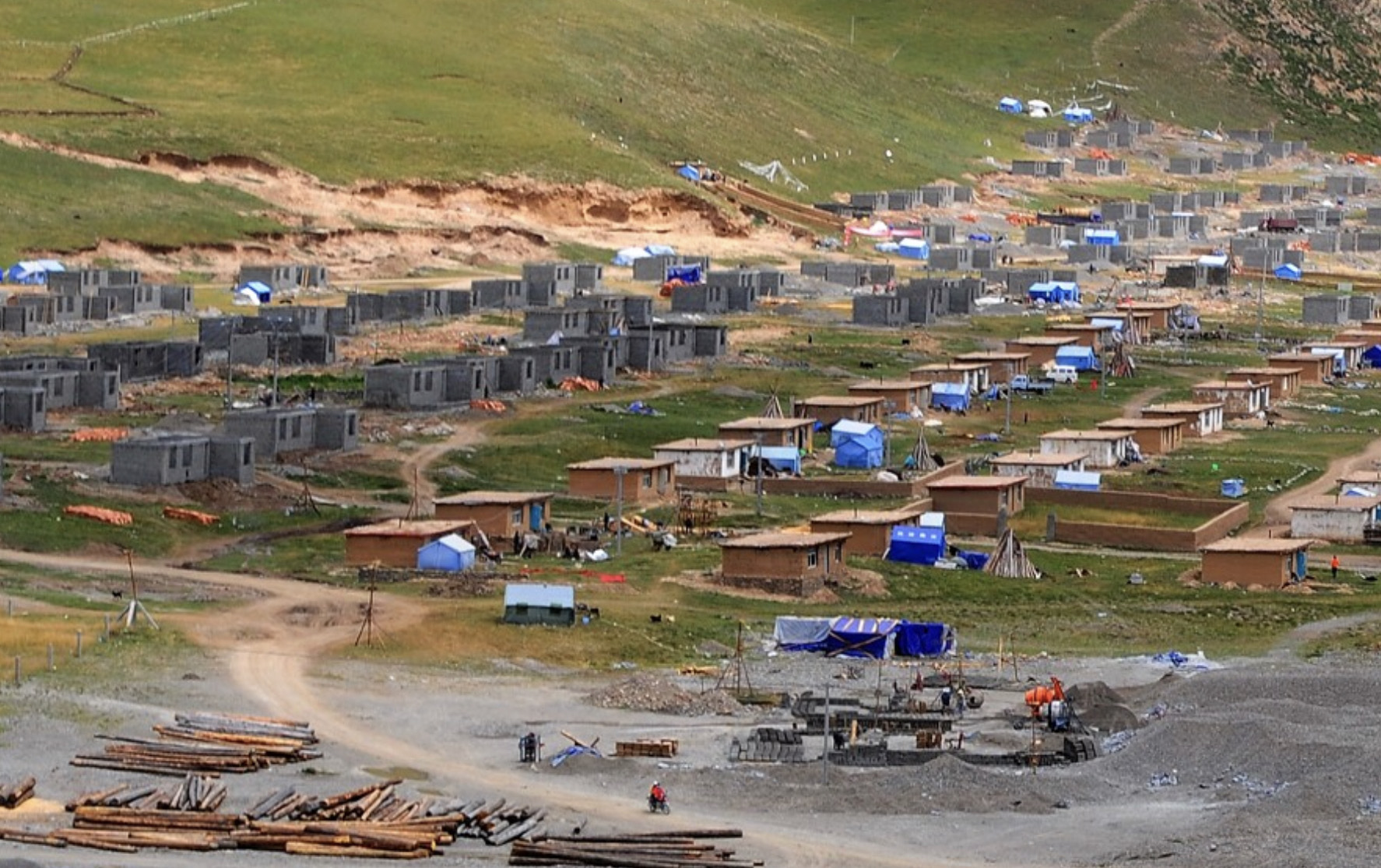
China believes its policy of forced resettlement that began in 2003 under the tuimu huancao slogan is necessary to alleviate poverty among nomadic communities.
Resettlement policies are typically carried out with little consent or consultation with affected communities. They have no means to challenge the policies or to refuse to participate in resettlement programs. Nomads are typically moved into purpose-built concrete compounds, often far from employment opportunities and essential services. Language barriers, prejudice and other disadvantages often make it hard for the newly settled Tibetans to enter the increasingly Chinese-dominated workforce.
One detailed case study of resettlement in the Sanjiangyuan area in the centre of the Tibetan Plateau uncovered a heartbreaking catalogue of negative social and economic consequences for the former nomads. Stripped of their traditional livelihoods and presented with few new employment opportunities, interviewees struggled to meet their most basic needs.
“Everything here costs money. A slice of meat costs 10 RMB, so does a bag of livestock dung [for household fuel]. We can’t afford them. When we lived on the grassland, we didn’t need very much at all. We got everything from our livestock.”
Tragically, the impact of resettlement goes beyond the loss of livelihoods and security, and can profoundly impact a community’s identity, cohesion and spiritual wellbeing. Unfamiliar surroundings and dislocation from ancestral land can leave individuals and whole communities unmoored, lacking any sense of belonging, and severed from everything that had given life order, grounding and purpose. This may lead to increased alcohol consumption, crime and other social problems.
Overall, while resettlement may initially come with promises of better access to healthcare, education and other benefits, accounts consistently show nomadic communities becoming worse off after the relocation. As noted by the Central Tibetan Administration:
“Tibetan nomads, who once lived happy and self-sufficient lives, have been suddenly thrust into dislocation and poverty. Ultimately, this is the state-engineered destruction of a culture and a way of life.”
One of China’s core arguments for the forced removal of nomads from their pastures is that it is necessary for their good because they are poor and their poverty is the inevitable outcome of having to live in such a harsh landscape and that the only solution is relocating to the fringes of distant towns. China labels this contiguous poverty, the toughest to eradicate, because it arises due to the absence of all factors that encourage productivity. Officially they are called contiguous destitute areas (个集中连片特困区贫困).
Tibetan pastoralists do not see it that way. They consider themselves the gatherers of what nature seasonally provides, with many months each year when there is little work to be done, and plenty of time to undertake long pilgrimages or trading expeditions, honour local gods, weave tents and ropes or teach the young.
Far from feeling poor out on the open range, there is a deep nomad tradition of tsethar, freeing animals for life, marking herd animals, so everyone knows they are to peaceably live out their full life on the pasture, with no threat of sale or slaughter. This widespread practice has gained momentum in recent years, despite China’s pressure on nomads to behave more like industrial commodity agribusinesses, sending animals for slaughter much faster and younger.
Tibetan nomads know Chinese and other outsiders see their life as hard, close to bare subsistence and even aimless since they wander with their animals. The nomads consider such views absurd, since livestock management and production, while also curating entire landscapes, protecting wildlife and maintaining plant biodiversity are skilled work, all based on a willingness to maintain mobility. Nomads often talk of wealth, not poverty. In Tibetan, wealth is nor, and the best of all nor is a herd on the hoof, on an alpine meadow, fattening on the abundance nature seasonally provides.
So when nomads are vexed by demands, they reduce herd size, sell stock younger and more often, downsize or altogether end what they learned from earlier generations, to keep whole landscapes healthy and productive, by mobile, moderate grazing.
China’s view distresses nomads, and also Tibetan officials in local government:
“Overall, pastoralists in our county regard the rangeland contracting policy as a demon and reject it. First, people do not accept the idea of dividing all the land – they are concerned about livestock grazing and disputes over the land after it is divided. But it is a very bad idea to divide all the land. Also, dividing the land makes it very difficult to graze livestock as it will redistrict livestock mobility. It will keep livestock well fed and happy if they can move around to graze.”
In recent years, science has caught up, discovering that moderate grazing results in the greatest grassland biodiversity. Heavy grazing endangers plants, which the nomads have always known. Removing grazing results in an immediate flush of biomass, but reduced biodiversity as long grasses crowd out delicate herbs essential to traditional Tibetan human and veterinary medicine manufacture. If grazing is removed for a few years, there is no further accumulation of biomass and carbon, but grassland becomes shrubland, which is no longer productive.
Chinese scientists and policymakers, however, have spent decades operating on the simple assumption that all grazing is degradation of plant biomass. Officially, this is expressed as a Marxist dialectic: “There is a contradiction between grass and animals.” The solution to this contradiction is that herds and herders should be removed.
Since China never invested in adding value to nomad production such as wool, dairy and animal products, incomes in rural Tibet now lag far behind incomes in the heavily subsidised towns and cities of Tibet where Chinese settlers live, where there is plenty of state employment for security personnel. China’s massive investment in infrastructure across Tibet is largely confined to the mines, dams, power grids, urban centres and network of highways and railways connecting these nodal enclaves. Rural Tibet remains without effective linkages to lowland China, even though urban China has a big appetite for yoghurt and other dairy products. Inequality is now extreme in Tibet and throughout China.
So rural Tibetans are now relatively poor; a matter of distributive justice. That does not mean they want to leave their land or see moving to urban fringe settlements as the solution. Even after they are resettled, and their land tenure security cancelled, they still consider themselves to be nomads, and often manage to outsource their herds to those who remain on the land. Urbanisation is now China’s solution to everything, but nomads, who seldom speak Chinese and even less often read or write it, are effectively shut out of urban labour markets except for casual, unskilled work in road making and construction labouring.
On paper, China argues that these displaced nomads are wealthier because of transfer payments from the central government. In return, those removed are required to show gratitude at the benevolence of central authorities in raising not only cash income but also their level of “civilisation”. According to official statistics, transfer payments in rural Tibet have reached RMB 2167 per person per year, around US$310. For nomads displaced to urban fringes, those transfer payments are usually bags of rice and subsistence rations, of low quality, poor substitutes for formerly proud, independent food producers.
Biodiversity: Creating wilderness
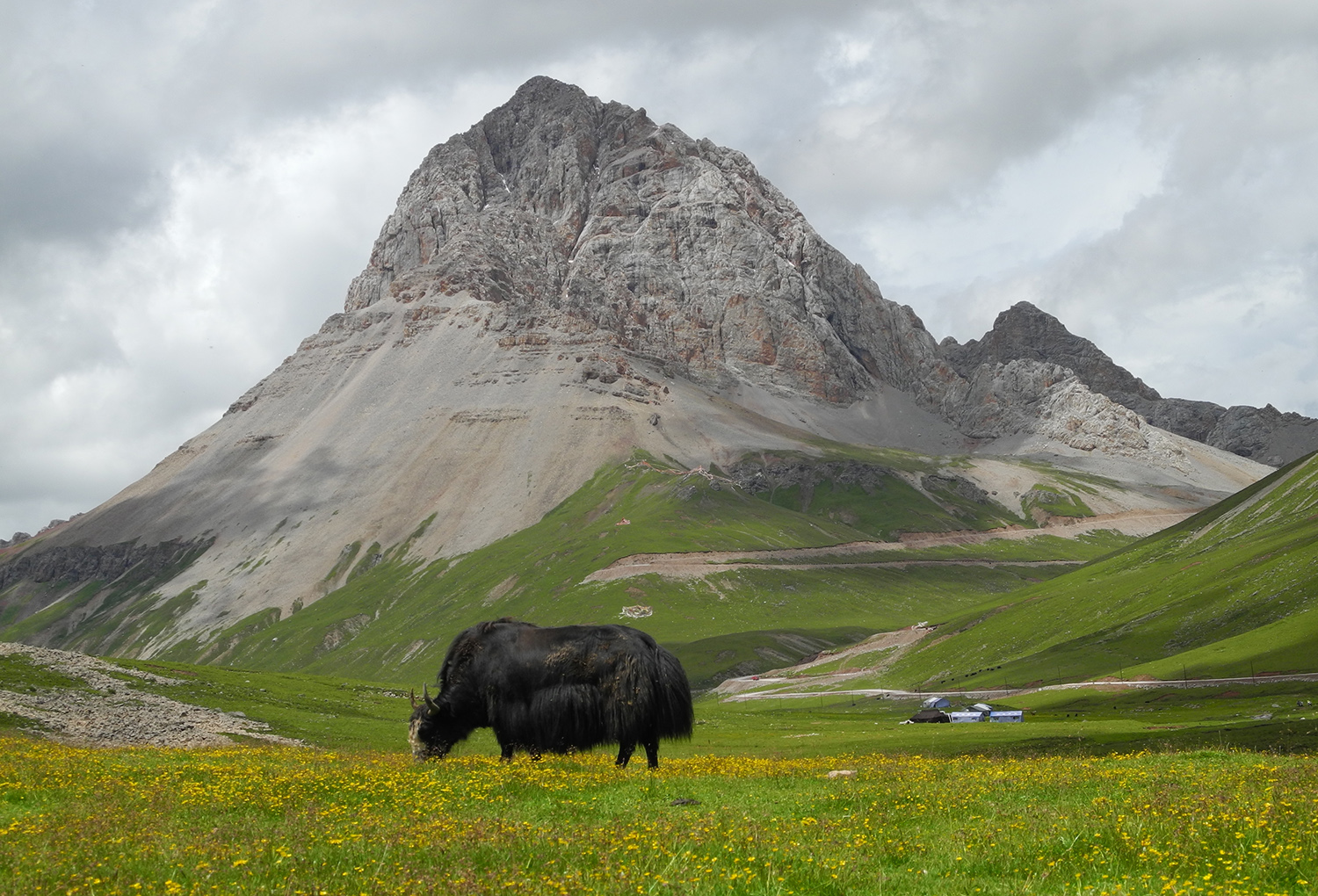
© Nigel Hungerford
China’s clincher for many new national parks that largely exclude nomads from their pastures is biodiversity, and the official goal of creating a pristine, unpeopled wilderness that will attract mass domestic tourism.
China has recently discovered the biodiversity of the Tibetan Plateau and the need for conservation of endangered species. For decades, the remote pastures and mountains of Tibet were a wild west, where illegal miners and wildlife poachers roamed with impunity, held accountable only by Tibetan patrols willing to confront the well-armed hunters.
Now the state has taken over, disbanding the famous Tibetan Wild Yak Brigade of wildlife protection rangers. Drawing red lines on maps, declaring large territories to be national parks, is now the official method of protecting wildlife, with many exclusion zones in which all human activity (other than scientific research) is banned.
Bottom-up community-based approaches have been ignored. This worries the specialists in Chinese studies:
“The top-down approach is prioritised in the planning and management of the national park system, and the involvement of civil society groups in the making of China’s national parks does not guarantee an inclusive and bottom-up approach. From the 1970s onwards, worldwide the conservation paradigm gradually shifted to recognise the importance of a participatory and inclusive approach to protected area management. China’s moving away from such understanding and practice may eventually undermine the rights of local communities and threaten to hamper the conservation goals that the national parks aim to achieve.”
“Top-down” is not a term applied only by outsiders to describe the design, operations and management of China’s new national parks. It is also how China’s central planners see it themselves. The official phrase 自上而下, zi shang er xia means top-down, designed by top-level computerised systems theory.
From the 1980s to 2000s, many of the world’s leading conservation NGOs were active in Tibet. Some formed close partnerships with Tibetans keen to conserve wildlife and habitats, at a time China ignored its lawless wild west, allowing rapacious slaughter and extraction to persist. Some of those NGOs still quietly work on the ground to mitigate the imposition of top-down models.
One of the earliest to understand the importance of Tibetan wildlife was Conservation International (CI), which set up a Critical Ecosystem Partnership Fund, a joint initiative of l’Agence Française de Développement, Conservation International, the Global Environment Facility, the Japanese government, the MacArthur Foundation and the World Bank.
CI’s program The Mountains of Southwest China identified the location of the Tibetan biodiversity hotspot – not where most of the new national parks are but in Kham, including parts of western Sichuan, northwest Yunnan, eastern parts of Tibet Autonomous Region, the southeast tip of Qinghai and the southern tip of Gansu. This huge hotspot is home to about 50 percent of the country’s birds and mammals and more than 30 percent of its higher plants.
However, only a fragment of this massive hotspot will be protected under the new national parks to be unveiled next year. China has instead turned to the three rivers source, the Sanjiangyuan, to the north, which is far less biodiverse, but the source of China’s biggest rivers, essential to water provisioning for lowland China.
In China’s domestic tourism market, and with animal lovers worldwide, protection of iconic wild species is a winner. There is an immediate, wholehearted connection to photos of headline endangered species such as snow leopards, pandas, wild yaks, gazelles and antelope. Is this newfound concern to protect wilderness what drives China’s new system of national parks? Does biodiversity conservation necessitate excluding most nomads from lands they have always curated and cared for?
China will no doubt receive significant international praise when it launches its new system of national parks. Powerful actors will be willing to overlook the darker side of this program and herald another sign of environmental leadership from China, at a time when the world is grappling with the twin challenges of climate breakdown and biodiversity loss. This unfortunate reality heightens the need to better understand the motivations and mistakes behind China’s ongoing moves, the consequences for Tibetans and Tibet’s environment and to advocate for a better path forward.
Tibet and China are already teeming with various types of protected areas, managed variously at the national or provincial level, including nature reserves, UNESCO World Heritage properties, and Ramsar protected wetlands.
China’s new national parks system will see some existing protected areas upgraded to National Park status, while others will have their boundaries redrawn and modern management practices put in place to bring them to the new standard. Management of the parks, along with other types of protected areas, is now centralised under a new National Forestry and Grassland Administration, and the different types of protected area consolidated into fewer categories. Design of the Sanjiangyuan and Qilian/Dola Ri parks has been facilitated by a major multi-year project of the UN Development Programme, financed by the World Bank’s Global Environment Facility.
Most significantly for Tibetans, China’s plan requires nearly all human activities except science and tourism to cease within these new national parks.
Protected areas in Tibet, including new National Parks
- Chang Tang
- Sanjiangyuan
- Mount Qilian/ Dola Ri
- Hoh Xil
- Tsaidam Haloxylon Forest
- Giant Panda National Park
- Kailash Sacred Landscape
- Chomolangma (Mount Everest)
- Three Parallel Rivers
- Pota Tso / Pudacuo
- Siling Tso, Kanlho, Kandze, Dzoge, Ngoring, Gyaring, Bird Island Tso Ngonpo
- TOTAL
- National Nature Reserve
- 334,000 sq km
- Mostly alpine desert
- National Park
- 152,300-363,000 sq km
- The 2020 launch of the smaller area, with only 72,000 remaining herders classified as resident, is to be expanded in later years to incorporate the full-size extent.
- National Park
- 50,200+ sq km
- Originally defined as 50,000km, though additional snow leopard habitat added to the south.
- UNESCO World Heritage property
- 37,356 sq km
- Inscribed into the World Heritage List in 2017. See Nomads in ‘no man’s land’ for impacts on Tibet’s nomads.
- Provincial Nature Reserve
- 37,345 sq km
- Arid area, heavily industrialised
- 2020 National Park
- 27,134 sq km
- Created by combining several scattered protected areas and the last remaining areas of giant panda habitat.
- UNESCO World Heritage property (nominated)
- 10,843 sq km
- Nominated for UNESCO World Heritage status in 2020 Transboundary. The area cited here refers to the section within Tibet only.
- National Park
- 3,381 sq km
- Mountain slopes and base camp
- UNESCO World Heritage property
- 17,000 sq km
- Highly fragmented, boundaries exclude the actual rivers, scheduled for hydro damming.
- National Park.
- 1,300 sq km.
- A small portion of the biodiversity hotspot of eastern Tibet
- RAMSAR wetlands
- Total: 6,949 sq km
- Habitat of black-necked cranes, endemic to Tibetan Plateau
675,000+ sq km
Map: Protected Areas in Tibet
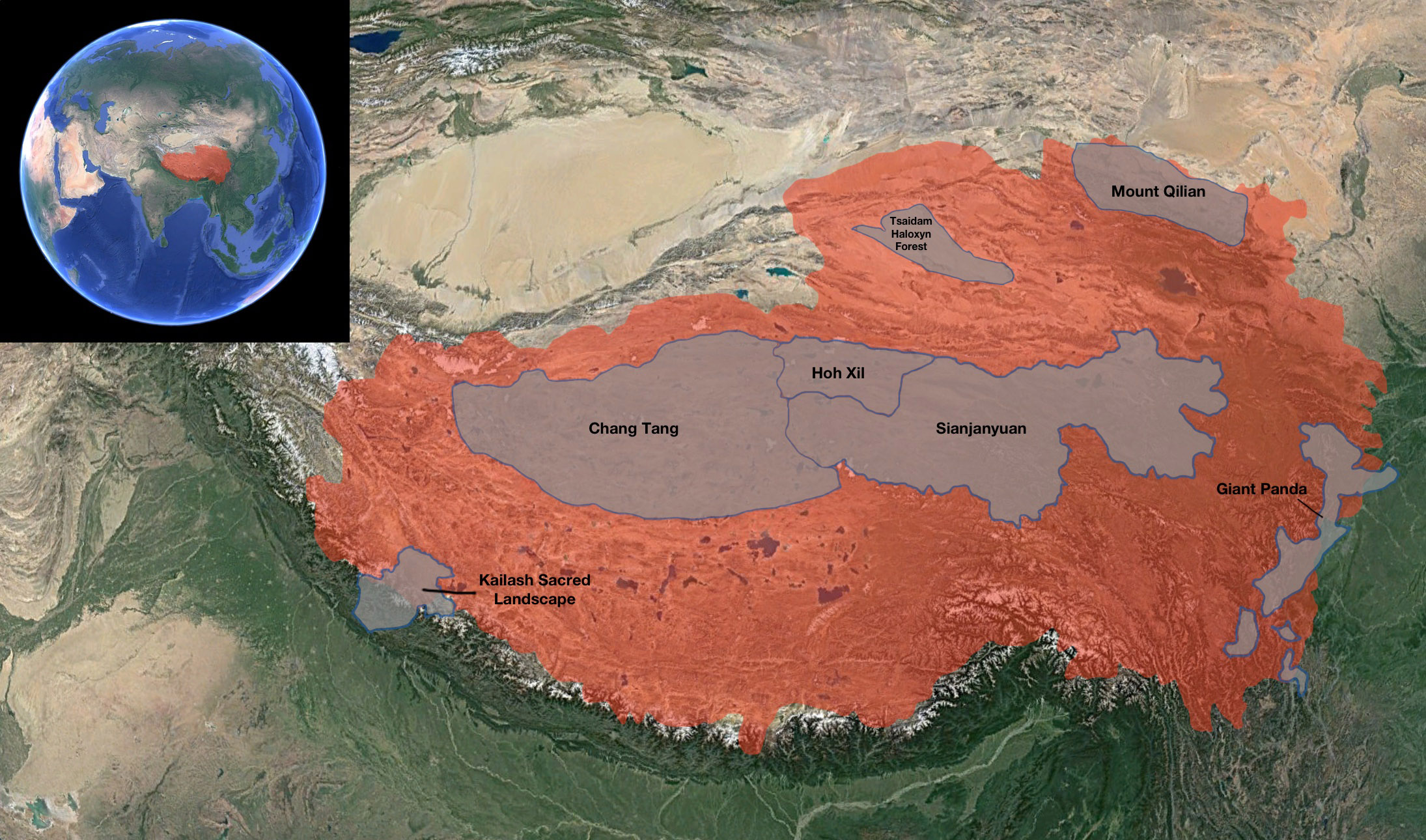
Sanjiangyuan National Park
The Sanjiangyuan region is the source of China’s three most important rivers – the Yellow, Yangtze and Mekong.
Tibetans have always known their rivers are the fountainhead of Asia’s great rivers, but never packaged their upper catchments into a single concept. To Tibetans, Sanjiangyuan swallows two entire prefectures, Amdo Golok and Kham Yushu, plus other counties as well. Together, they are prime pasture, a traditionally unfenced landscape abundant in wild gazelles and antelopes, also supporting herds of yaks, sheep and goats rotated through a pasture by skilled herders always moving on well before any sign of overgrazing.
Now the Chinese government is taking over and packaging it as Sanjiangyuan National Park. In the name of science, all human presence, apart from scientists, will be declared a threat. A small portion of locals, no more than 17,000 people, are to be employed as rangers to enforce the ban on livestock production and the pastoral way of life.
To grasp the significance of this region, consider just one of these rivers – the Yellow. The 5,500 km Yellow River is often called the “Mother River” of China or the “cradle of Chinese civilisation”. It is the lifeblood of northern China, supplying water to 155 million people (12 percent of the population), irrigating 15 percent of the country’s farmland, and supplying several major industrial centres. The Yellow River gets nearly half of its flow from glaciers and underground reserves in Sanjiangyuan. The region is also habitat for many iconic species of wildlife, most notably the snow leopard.
As covered in the previous section of this report, Tibetan nomads played a critical role in protecting the delicate ecological balance of Tibet’s grasslands, including Sanjiangyuan and the source of Asia’s great rivers. Not only did the nomads and their herds mingle with the region’s wildlife, including migratory wild herds of Tibetan antelope, but the nomads also worked actively to protect the region’s wildlife. For example, in neighbouring Hoh Xil, now a World Heritage Property, the population of Tibetan antelope used as a mascot for the 2008 Beijing Olympics plummeted under Chinese control. Their numbers have slowly increased after the nomads risked and lost lives protecting the Tibetan antelope from poachers.
The Chinese government’s program of resettling nomads in Sanjiangyuan has been underway for close to two decades. Lack of official data makes it difficult to discern how many nomads still roam free in Sanjiangyuan. Around 200,000 people traditionally live within the area. One source from 2012 claimed that 100,000 had been removed from the grasslands at that point. Whatever the current status of nomads within Sanjiangyuan, the government’s national parks plan makes clear its intention to remove nearly all nomads and their herds from the grasslands.
Giant Panda National Park
The new Giant Panda National Park will be around three times the size of America’s Yellowstone National Park. It will bring together dozens of existing panda reserves and other protected areas, connecting much of the pandas’ scarce remaining habitat into a single national park. It is almost wholly in Tibet, in mountainous old-growth forests where the pandas can find their primary food bamboo.
The park will be set up around a series of core protected areas that prohibit all human activity including herding, farming, mining, logging and tourism. While fewer restrictions apply to the parks “general control zones”, China’s state news agency has reported that at least 170,000 people would have to relocate or adapt to new restrictions as part of the park’s overall plan.
While the new park may bring some additional jobs and revenue to the region, including through tourism, lessons from elsewhere in Tibet suggest local communities will not be the beneficiaries. The Chinese government is providing incentives, including education opportunities, to encourage relocation. However, past experience again gives Tibetans strong cause to doubt the extent to which such promises will materialise.
PART 3: FURTHER ISSUES
Is “ecological migration” voluntary or coerced?
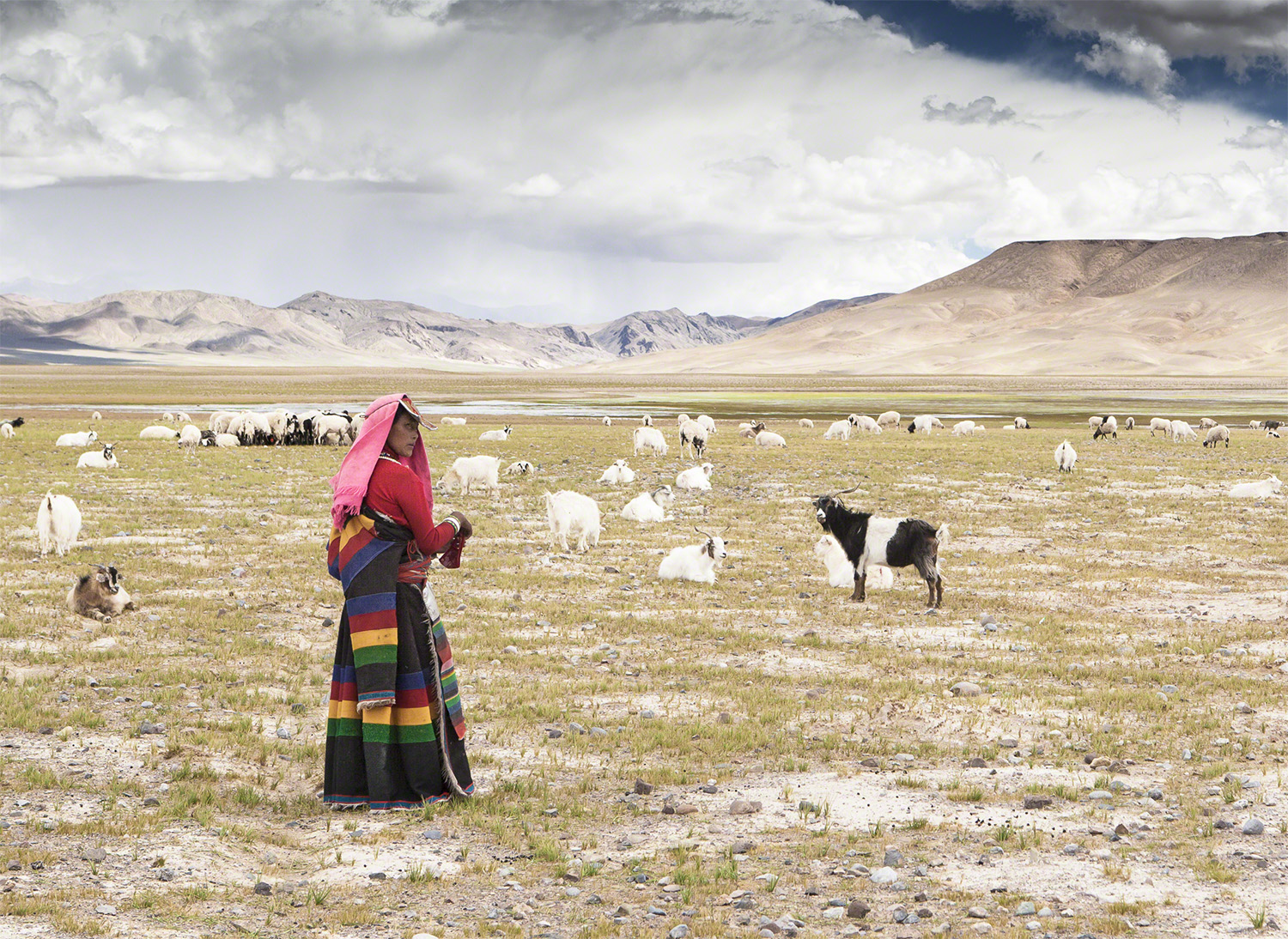
© John Birchak
Tibetan nomads are pushed and pulled to leave their customary lands and start at the bottom of a highly competitive urban society. Those not literate in standard Chinese remain at the bottom. For the young, the pull, offered by the 24/7 mobile connectivity, is strong. For their parents, who have experienced the life of the land, the pull of urban life is less attractive, and the freedom of the open range is tangible.
“The most enjoyable thing to do is to watch over the yaks because in the mountain there is everything. If it’s too sunny, we can hide on the shadows. If it’s too hot, we can go to stay beneath the trees. The mountains provide us with everything we could ever want and I really enjoy it.”
Tibetans in old age are good at turning away from the concerns of this life, as they prepare for the next. For them, urban life is premature death. It may bring expensive access to healthcare, but the purpose of life disappears with the cancellation of land tenure rights and the compulsory sale of the herd. There is nothing left, but to prepare to die.
Researchers who interviewed nomads in the Sanjiangyuan park, in their customary villages, on their land, and among those relocated to resettlements, report:
“Over 95 percent of the interviewed people revealed that they did not want to move to the resettlement and preferred to live their life in the grasslands. The small percentage of people that declared they were happy about the resettlement were elders that did not have family members to take care of them, but also in this case they answered that they missed the life in the rangelands.
Finally, a fundamental difference that emerged between the traditional village and the resettlement is the level of cooperation. In the traditional village, every interviewed household declared that they could rely on cooperation with members of the same village for several group activities such as house building, black tent making, taking care of children and harvesting activities. Also, the social trust in the village appeared very high and most of the members declared to know everyone in the village and ‘had their doors open’ for people to come.
On the contrary, in the resettlement sites, the level of cooperation changed. The resettlement sites are mixed with households coming from different villages. As a result, cooperation is limited to households from the same village, and there are very little social relationships between people from different villages. The level of trust towards other members also appeared low, and the interviewed people declared in most of the cases to be afraid of thieves and damage to their properties.”
That fieldwork was done between 2007 and 2011 when resettlements were low rise concrete constructions, densely packed. Since then, nomads have been increasingly resettled in high rise apartment blocks, at much greater density, among strangers.
Australia Tibet Council respects the choices nomadic families make, even if the consequences of depopulating vast areas may be alarming. However, that move to urban areas must be voluntary, not pushed by racist contempt from the Chinese government.
Local government officials implementing orders from Beijing are openly racist, regarding the nomads of low human quality, leading lives not much different to the animals they herd. In the eyes of officials, social development in nomadic districts is so little and poverty so inherent to the land, that there is no hesitation in pushing people out.
The prevalent official attitude is also inherently arrogant. Anthropologist Charlene Makley found in her fieldwork in Tibet:
“From the perspective of Langmo villagers, it was state officials who were inscrutable, unsensing interlocutors, their visits seemingly random, their motives opaque or arbitrary. As one elder adamantly insisted to me: They refuse to see with their own eyes.”
The precondition for these mass displacements should be free, prior and informed consent, but in practice, removals occur when cadre officials go to a village, announce a quota of removals to be fulfilled, and push until the required number agree. Since health and education services are more than ever concentrated in towns, nomadic families with young children or elderly in need of access to medical care are usually the first to sign away their land rights.
Land tenure, conservation and food security
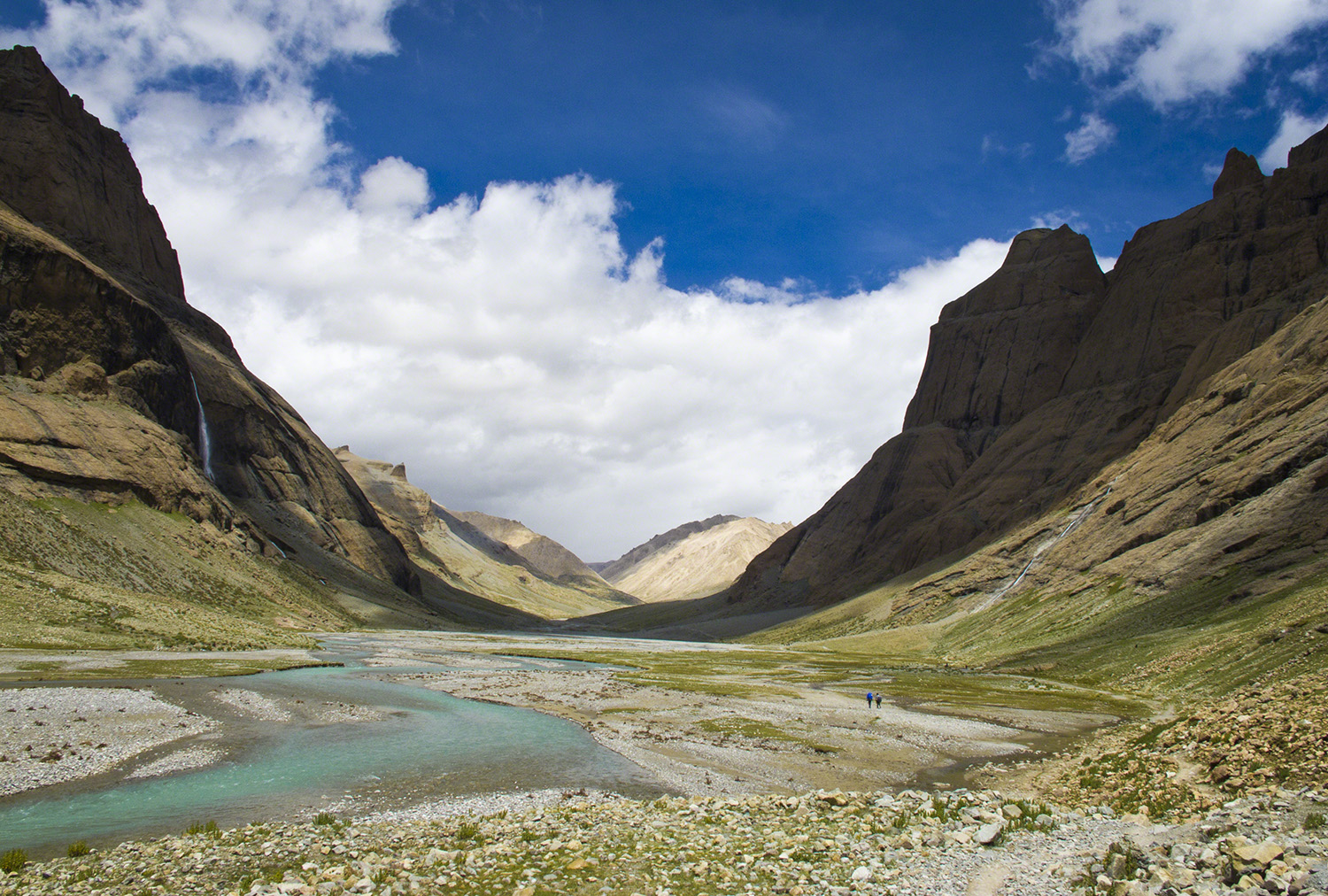
© John Birchak
Worldwide, land tenure security is essential to sustainable development. The Global Landscapes Forum (GLF) emphasises the “fundamental importance of rights to address the current environmental crisis.”
“Linking people to landscapes, the GLF will explore the essential contributions of indigenous peoples, local communities, and rural and indigenous women and youth in achieving the Sustainable Development Goals (SDGs) and the Paris Agreement targets on climate change, highlighting the transformative role of rights and rights-based approaches in securing a more just, sustainable and prosperous future for all.”
A 2018 study compared conservation outcomes in lands (in this case forests) controlled by indigenous groups against those in government-managed reserves in 28 countries. The report found that the rate of deforestation on customary land was on average half of what it was elsewhere. The study, one of many to draw such conclusions, found that “the best way to save forests and curb biodiversity loss is to recognise the claims of indigenous peoples to their territories”. This is what is utterly absent in Tibet.
When the production landscapes of Tibet are emptied of people and their herds, the consequences go beyond individual families. Tibet, close to two percent of the land surface of the planet, loses food security, the ability to self-sufficiently feed itself, and must rely on food imported over great distances from inland China.
“Even mild food insecurity leads to a host of negative psychosocial consequences, including feelings of exclusion, powerlessness, desperation, fear, stress, disrupted household dynamics, deviant behaviour and revolts. More serious food insecurity can contribute to the depletion of economic bases, distress migration of masses, conflicts, famines and death.”
Food security is fundamental to Sustainable Development Goals, at a time when there is a global concern that China threatens food security in prime agricultural districts in Africa and elsewhere by buying the best land for intensive crops to feed China. Closing rich pastures across vast areas of Tibet does not help.
Are nomads part of the solution?
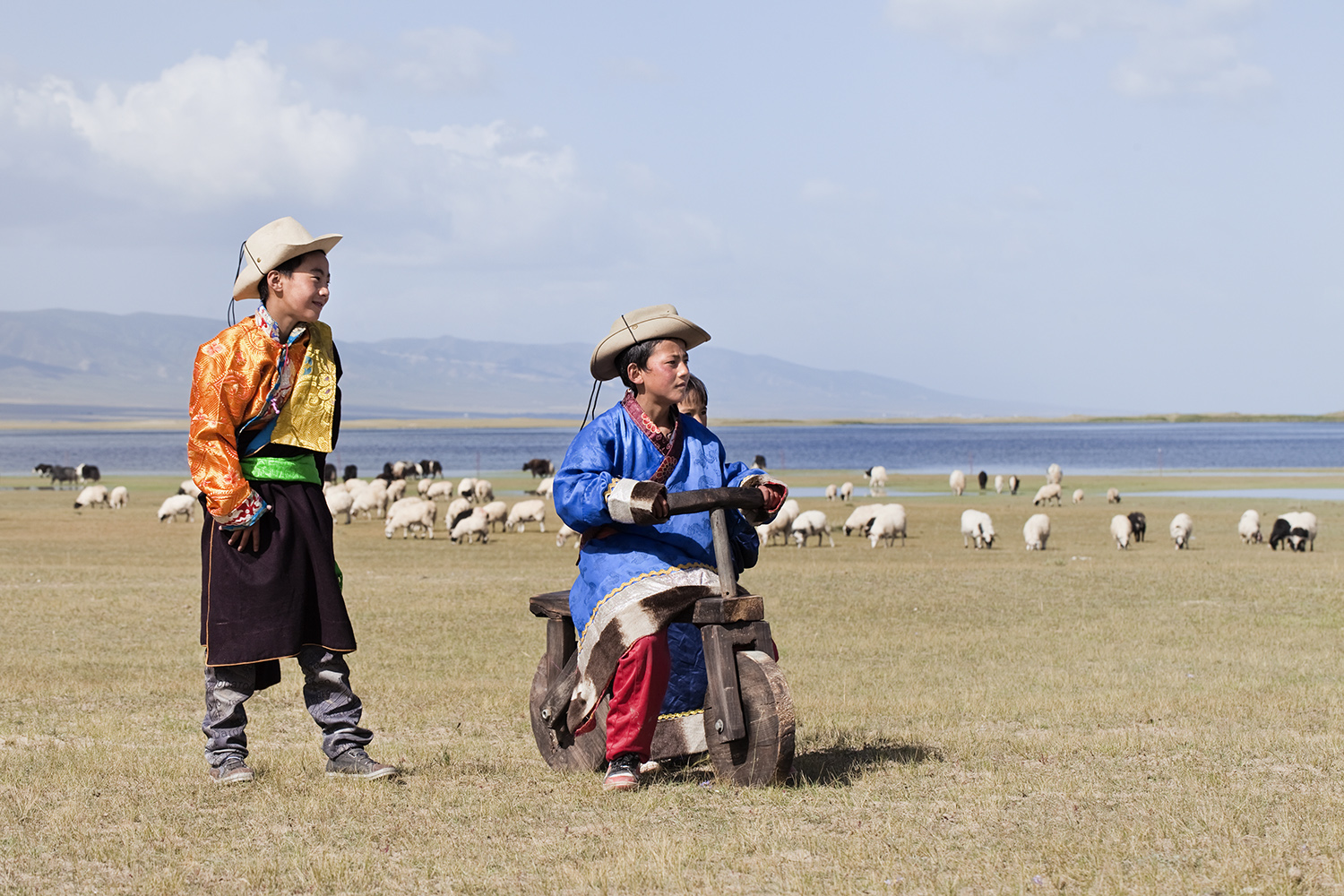
In the official gaze, Tibetan nomads are only a problem, not part of the solution. Tibetan nomads know how to be both productive and sustainable, how to graze livestock and ensure healthy rangelands and plenty of feed for wildlife. After thousands of years of sustainable co-existence of wild and domestic herds, there is no need to trash traditional knowledge and exclude human use in the name of biodiversity conservation. This is a false either/or choice.
The designated role for nomads within the considerable area designated for the 2020 launch of the national park system, is as state employees tasked with enforcing state policy, including the closure of pastures to grow more grass. While park managers and researchers will be overwhelmingly Chinese, the lower level staff responsible for enforcement of parks’ core exclusion zones will be Tibetan. A year before the launch of the Three Rivers Source (Sanjiangyuan) National Park, the number of eco-management guards (名生态管护员持) was announced as precisely 17,211, to be trained and certificated after passing an official curriculum. They are recruited from 17,211 Tibetan families, thus guaranteeing each family one earner on the state payroll, with sufficient income above the very low officially defined poverty line.
This achieves both poverty goals and implementation of exclusion zones in which grazing is no longer permitted. As long as the 17,211 park wardens implement the official line, they have jobs for life, which Chinese call an iron rice bowl. There will be plenty of applicants, attracted by the certainty of state employment, in a highly uncertain landscape made more uncertain by climate change. Chinese officials explicitly attract applicants by calling this the sweet taste of the green rice bowl (如今端上了‘生态碗’,吃上了‘绿色饭).’
The offer of a guaranteed state income comes after decades of the official policy requiring nomads to destock, reduce herd size, adhere to carrying capacity limits set by distant scientists, and accelerate slaughter rates. Climate change and the allocation of limited land tenure, while reducing nomadic mobility, have all had cumulative impacts on nomadic life. All these changes have pushed nomads into poverty.
Nomads tell visitors that grass is no longer as nutritious or plentiful as it was some years ago and consequently their animals no longer grow as big. The number of animals needed to maintain a viable nomadic family increases, yet for decades China insisted herd size decrease. Tightening poverty is the outcome, leaving nomads keen for one in the family to have a guaranteed income.
In their own words, nomads say:
“Every nomad depends entirely on grass. So when these grasses are decreasing in quantity, the milk is also decreasing in quantity. The bodies of our yaks used to be huge, really very big, but now they cannot grow as big as they used to be. Also, the dri [female yak], they cannot produce a lot of milk like they used to. The grass is decreasing annually.
This idea is related to environmental degradation. All of nature gets a problem, wildlife gets issues. It impacts our lives because our lives depend on livestock. Before we didn’t need to feed livestock anything else besides regular grazing on the mountains, now we have to feed them wheat and barley. This is due to changes in the earth. Because the government builds a lot of roads and also there is a lot of mining, it’s the changes because of this. The four elements should be balanced, sometimes it should be hot and sometimes cold, but now it’s hot when it should be cold and cold when it should be hot!”
Since 2009, more than 150 Tibetans have set fire to themselves in protest against Chinese policies in Tibet. Many have died from the self-immolations. A number of these Tibetans were either nomads or from a nomadic background, indicating growing distress among these communities caused by the dispossession, poverty and other impacts inflicted upon them by the forced relocation.
PART 4: A WAY FORWARD
Global partners, global standards

© Peter Campbell
Tibetans should enjoy their rights, individually and collectively. Secure land tenure is a right, as is food security.
Rangelands can be both sustainable and productive. Wild and domestic herds can coexist. Nomads and biodiversity conservation go together. National parks are compatible with careful moderate grazing; in fact, recent scientific studies show that moderate grazing is best for maintaining biodiversity, especially of the herbs on which Tibetan medicine is based.
Environment and development can go together; that is the key message of the UN Sustainable Development Goals agreed to by all countries, China included. Those 17 goals, with a target date of 2030, are the world’s best effort at doing conservation, gender justice, pollution control, poverty alleviation, climate change minimisation and much more, together, not an either/or. The SDGs are backed by multilateral finance. Governments that provide international development assistance are reminded that inclusive and successful biodiversity conservation are all part of development.
Global standards include global treaties China has signed and ratified and is bound by. These include the UN Convention on Biodiversity (CBD) which, in Article 8(j), names explicitly local and indigenous communities as the most successful protectors of biodiversity. The CBD has many ongoing processes to empower Article 8(j) as an effective way of ensuring traditional sacred spaces continue to be recognised as Indigenous and Community Conserved Areas (ICCAs), given comparable status to national parks. There have been many reports on the numerous sacred spaces, holy lakes and mountains and pilgrimage routes of the Tibetan Plateau.
The UN International Labour Organisation (ILO) in its’ Treaty 169 similarly elevates indigenous conservation knowledge to equal status to international law.
There is also the Indigenous Network of Mountain Indigenous Peoples, an international network of indigenous mountain communities in 11 countries. Established in Bhutan in 2014, it aims to revitalise biocultural heritage for climate adaptation and sustainable mountain development.
Upholding land rights and enabling indigenous peoples and local communities to continue with traditional land management practices is increasingly recognised around the world as an effective way of managing today’s environmental challenges, including stemming loss of biodiversity and curbing carbon pollution. Global experience in community and government partnerships in effective co-management governance of protected area is abundantly documented in many books.
Similarly, the recent Global Assessment on Report on Biodiversity and Ecosystem Services made compelling arguments for turning to indigenous peoples and local communities to help protect ecosystems. Also, the Paris Agreement on climate change commits countries, including China, to promoting human rights and the rights of indigenous peoples and local communities, when taking action to address climate change.
Is a win-win possible?
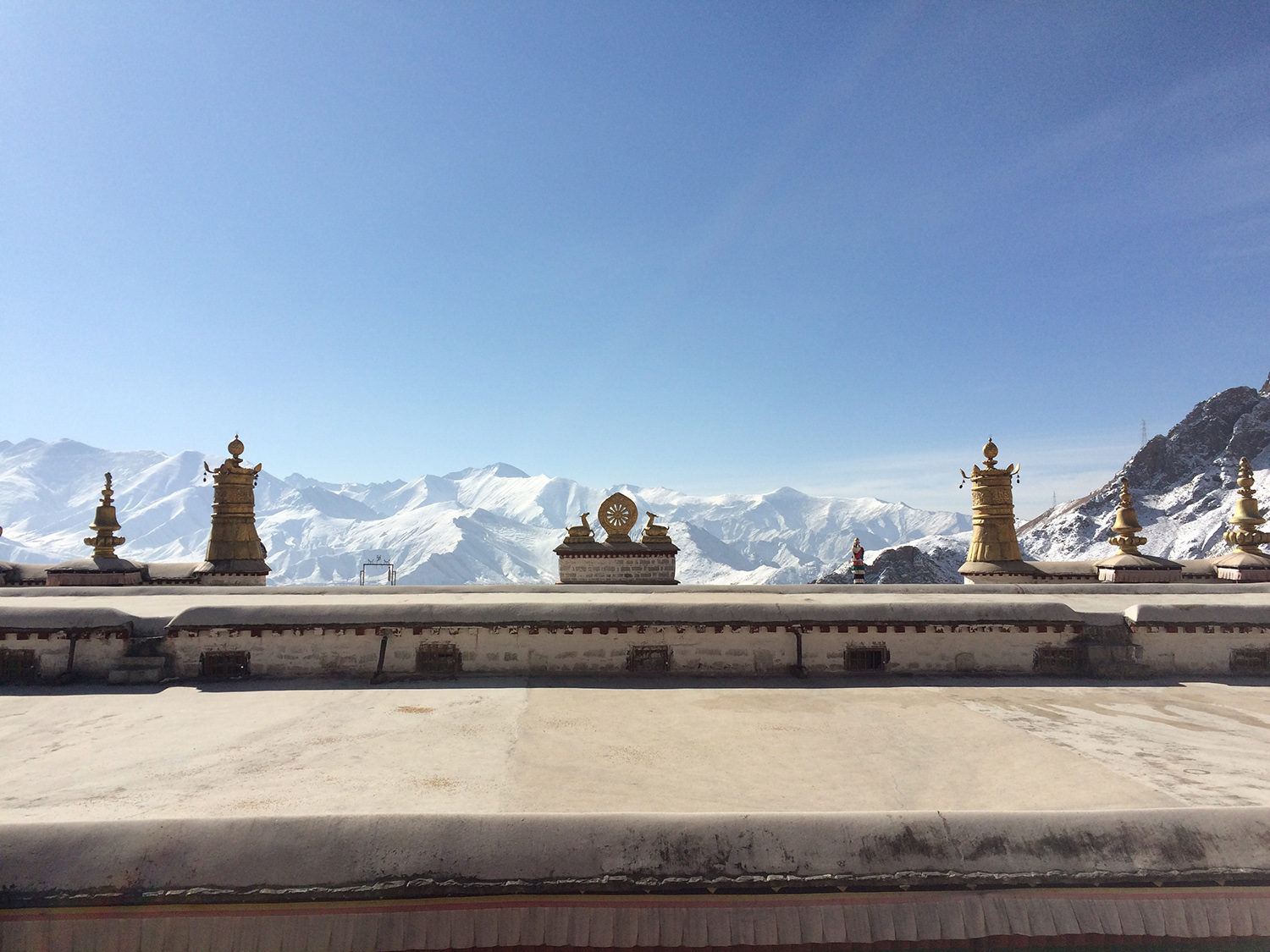
China’s leaders frequently announce policies they declare a win-win for all concerned. Is it possible to plan a win for Tibetan wildlife, for whole landscape protection, for delivery of water to needy downstream users, for climate change mitigation, for poverty alleviation and the rehabilitation of degraded pastures?
That might sound impossible, yet solutions are at hand. They are already pioneered in local communities in Tibet. These initiatives need to be scaled up. Pendeba, Tibet-Qinghai Plateau Youth Folk Environmental Education Centre, Yushu Prefecture Snowland Great Rivers Environmental Protection Association, Shan Shui and the Wild Yak Brigade are among the Tibetan civil society organisations bringing together scientists and communities, Chinese and Tibetan as well as international partners to show how to achieve China’s goals and the aspirations of Tibetans to live productively and sustainably on their land.
Dozens of Chinese NGOs have worked with Tibetans in the biodiversity hotspot of eastern Tibet. International NGOs working closely with Tibetan communities to protect wildlife biodiversity include International Union for Conservation of Nature, China Council for International Cooperation on Environment and Development, World Wildlife Fund for Nature, The Nature Conservancy, Wildlife Conservation Society, BirdLife International, TRAFFIC International, International Fund for Animal Welfare, WildAid, Global Environmental Institute, Arnold Arboretum of Harvard University, World Pheasant Association and International Fund for China’s Environment.
The outcome of decades of community-based conservation work is that there are now at least 10,000 Tibetans with training and experience in not only field operations but also accountability, capacity building, translating science and customary categories of the sacred to each other.
Many of these community initiatives are well-documented. To say China need not depopulate the vast rangelands of the Tibetan Plateau to achieve its stated objectives is not theory, it has been demonstrated on the ground, in many localities, over several decades. China now ignores these alternatives.
China seeks to demonstrate that it is exemplary in building an “ecological civilisation.” Best practice means bringing together officials and local communities in Tibet with long traditions of honouring water spirits and protecting sacred areas, to jointly plan and manage the repair of degradation and the productive use of rangeland pasture, combined with effective protection of wildlife.
China gives the highest priority to water retention and provision from Tibet, biodiversity conservation, degradation repair and carbon capture. All of these policy objectives are enhanced and are more deliverable on populated grasslands where, as in the past, wild and domestic herds can mingle, sentient life is respected, sacred sites are honoured, mobility moves herds on before overgrazing occurs. It’s not so hard to do. Tibetan nomads know how to do all of this, although they have at times needed reminders, from the highest lamas, that it is bad to hunt animals and wear furs.
CONCLUSION
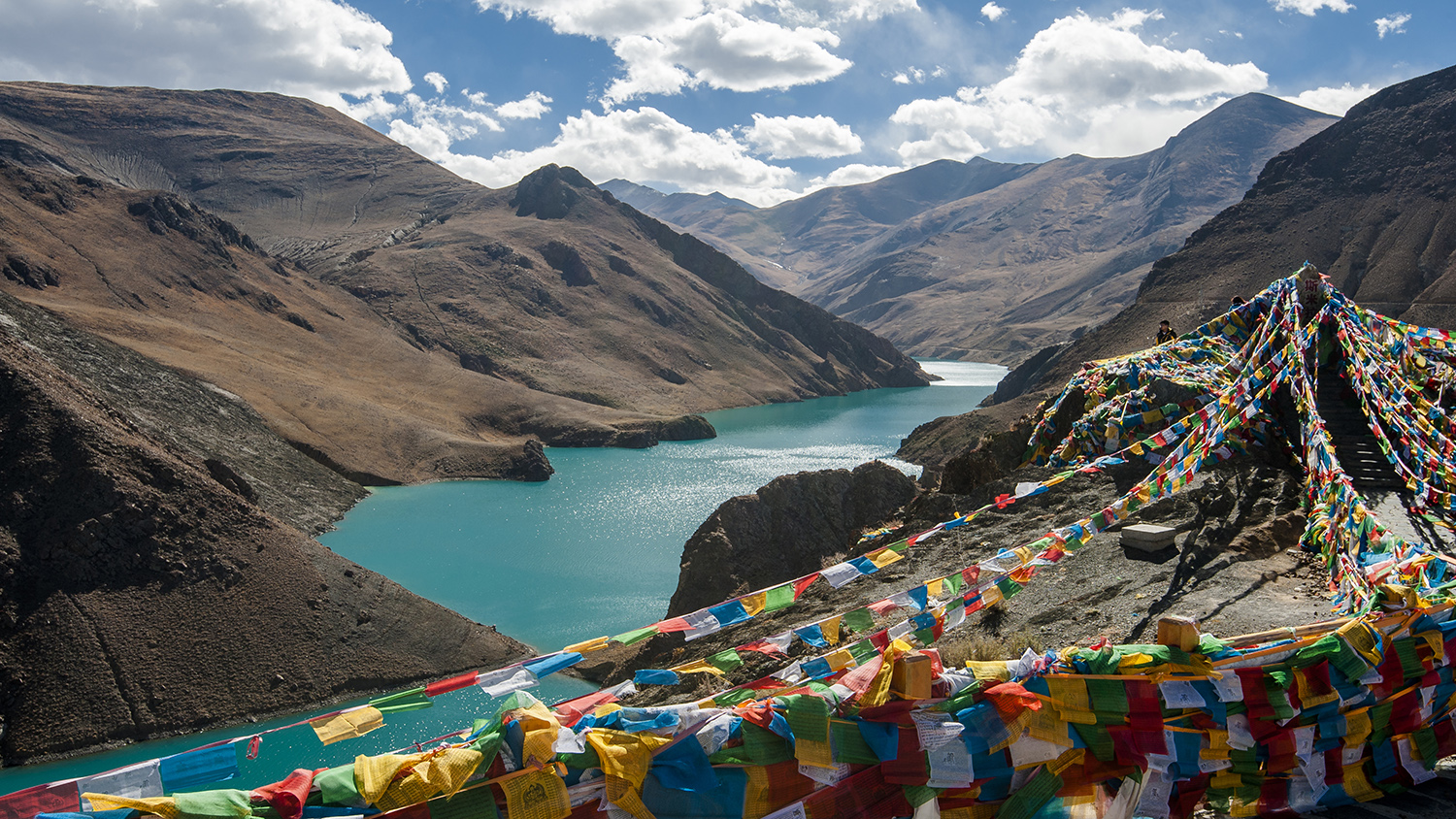
Worldwide, many indigenous peoples and local communities have suffered forced eviction in the name of conservation projects: forced off their land by state powers that were willfully blind to the vital role that the long-term inhabitants played in protecting wildlife and sustaining the ecosystem.
President Xi Jinping has worked hard to establish China as an environmental leader. He has made developing an “ecological civilisation” a key goal and one that is vital to China’s ongoing development. This is a stark contrast to President Mao Zedong’s attitude that nature was something to be conquered.
However, as for any other state projecting its nation-building power into new areas for state control, we must treat China’s efforts to rebrand itself as environmentally responsible with appropriate scepticism.
Tibetans may welcome new national parks in principle. Indeed, within Tibet, Tibetans have fought hard for the protection of the environment upon which they depend and which they hold sacred. Tibetans in exile have also fought China’s environmentally destructive policies while raising awareness of the importance of Tibet’s environment to the entire world.
Nor should it be assumed that all Tibetan nomads, in particular, younger generations would wish to continue their traditional livelihoods if offered alternatives. Ultimately, local communities should have the right to determine their future and choose their way forward, as part of a system that values their knowledge and wisdom, and seeks both the protection of the environment as well as upholding the rights, dignity and choices of those who call it home. The good news, as we have seen, is that these two objectives can, and indeed must, go hand in hand.
Good examples of collaborative management between herder communities, government agencies and non-government agencies exist in Tibet. Such projects also aim to increase access to education and healthcare to herder communities, without the need to relocate them from their traditional lands.
As China prepares to launch new national parks in Tibet in 2020, we encourage all concerned actors including international environmental and conservation organisations, development agencies – especially those with experience working in Tibet – and national parliaments and governments to:
- Ensure park planning comprehensively includes co-management strategies in which local communities and government are partners, which fully consider how to rehabilitate degraded areas most effectively, protect sacred areas and biodiversity, maintain food security in Tibet, preserve genetic diversity both among wild populations and domestic breeds, and perpetuate land tenure security for traditional landscape managers.
- Collectively press China to ensure that the rights of Tibetans, in particular nomads, as traditional stewards of the land, are fully protected and that they are empowered to make joint decisions affecting their livelihoods.
- Recognise the importance of traditional knowledge and partnerships in environmental protection and restoration globally, including in Tibet. Also, encourage collaborative management between herder communities, government agencies and non-government organisations as an alternative to the removal of nomads from the grasslands.
- Encourage efforts to increase decentralised access to education, healthcare and other services to Tibetan nomads, without need for relocation.
- Push for unfettered access to Tibet so that independent UN observers, foreign NGOs, scientists, ethnographers and media can comprehensively assess China’s plans.
- Refrain from welcoming China’s new national parks system until long term impacts are understood, and adequate measures have been taken to protect the rights and livelihoods of local communities, in particular, Tibetan nomads.
- Encourage an immediate halt to the forced removal of Tibetan nomads from their lands and for those already resettled to be allowed to return to their traditional lands if they so wish, with land tenure security restored.
- Recognise the critical importance of Tibet’s environment and how dramatic changes on the Tibetan Plateau, including the degradation of the grasslands, are impacting the wider world.
While Australia Tibet Council fully recognise the crises of biodiversity, climate damage and water security afflicting Tibet and the countries which depend on it, and the urgent need to protect Tibet for all humanity, we reject key aspects of the Chinese Government’s approach to conservation, most notably the forced removal of Tibetan nomads from the grasslands.
National parks should be welcome, but not if they exclude those who have actively cared for their land, sustainably and skillfully over thousands of years. Under its current directives, China’s new system of national parks would accelerate the forced displacement of Tibetan nomads and depopulation of rural Tibet, resulting in further ecological damage and the decimation of age-old culture and way of life. We believe that Tibetans, in particular, the nomads, offer a critical part of the solution. And that a better way forward is possible.

